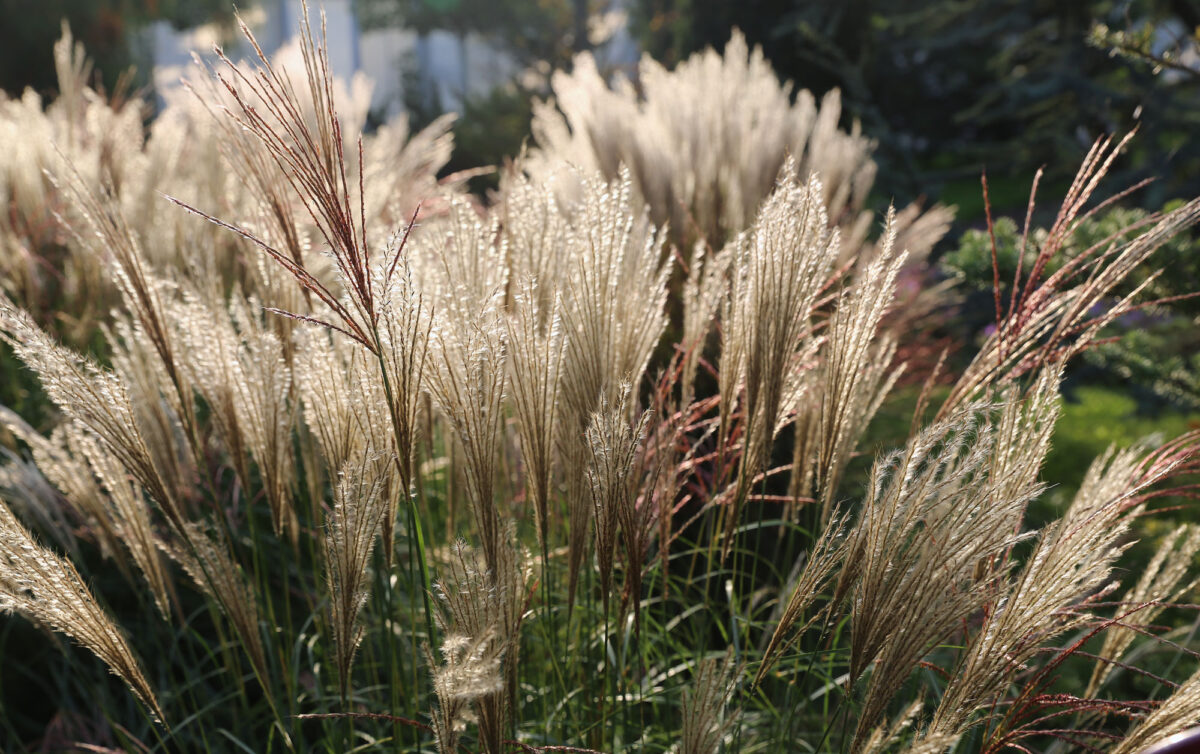Page snapshot: Introduction to the classification, diversity, and distribution of grasses in Tribe Andropogneae.
Topics covered on this page: Introduction; Subtribe Arthraxoninae (carpetgrass); Subtribe Tripsacinae (gamagrass, maize, and teosinte); Subtribe Chionachninae; Subtribe Rhytachninae (hippo grass and relatives); Subtribe Chrysopogoninae (false beardgrass); Subtribe Rottboelliinae (itchgrass and relatives); Subtribe Ratzeburgiinae (limpo grass and relatives); Subtribe Ischaeminae (murainagrass, sabaigrass, and relatives); Subtribe Germainiinae (satintail and relatives); Subtribe Sorghinae (sorghum and relatives); Subtribe Saccharinae (sugar cane and relatives); Subtribe Apludinae (Java grass, Mauritian grass, and relatives); Subtribe Anthistiriinae (lemon grass and relatives); Subtribe Andropogoninae (bluestem); Grasses not in a subtribe; Resources.
Credits: Funded by the National Science Foundation. Any opinions, findings, and conclusions or recommendations expressed in this material are those of the author(s) and do not necessarily reflect the views of the National Science Foundation. Page by Elizabeth J. Hermsen.
Updates: Page last updated January 11, 2023.
Image above: Chinese silvergrass (Miscanthus sinensis), cultivated, Austria. Photo by Manfred Werner-Tsui (Wikimedia Commons, Creative Commons Attribution-ShareAlike 3.0 Unported license, image cropped and resized).
Introduction
According to a recent classification by Welker et al. (2020), Tribe Andropoogneae is divided into 14 subtribes and includes more than 90 genera and more than 1200 species. The subtribes and examples of grasses within them are listed below. About 23 genera in Andropogoneae remain unclassified at the subtribe level because their relationships are not fully understood. As we learn more about the evolution of tribe Andropogoneae, these grasses will eventually be classified.
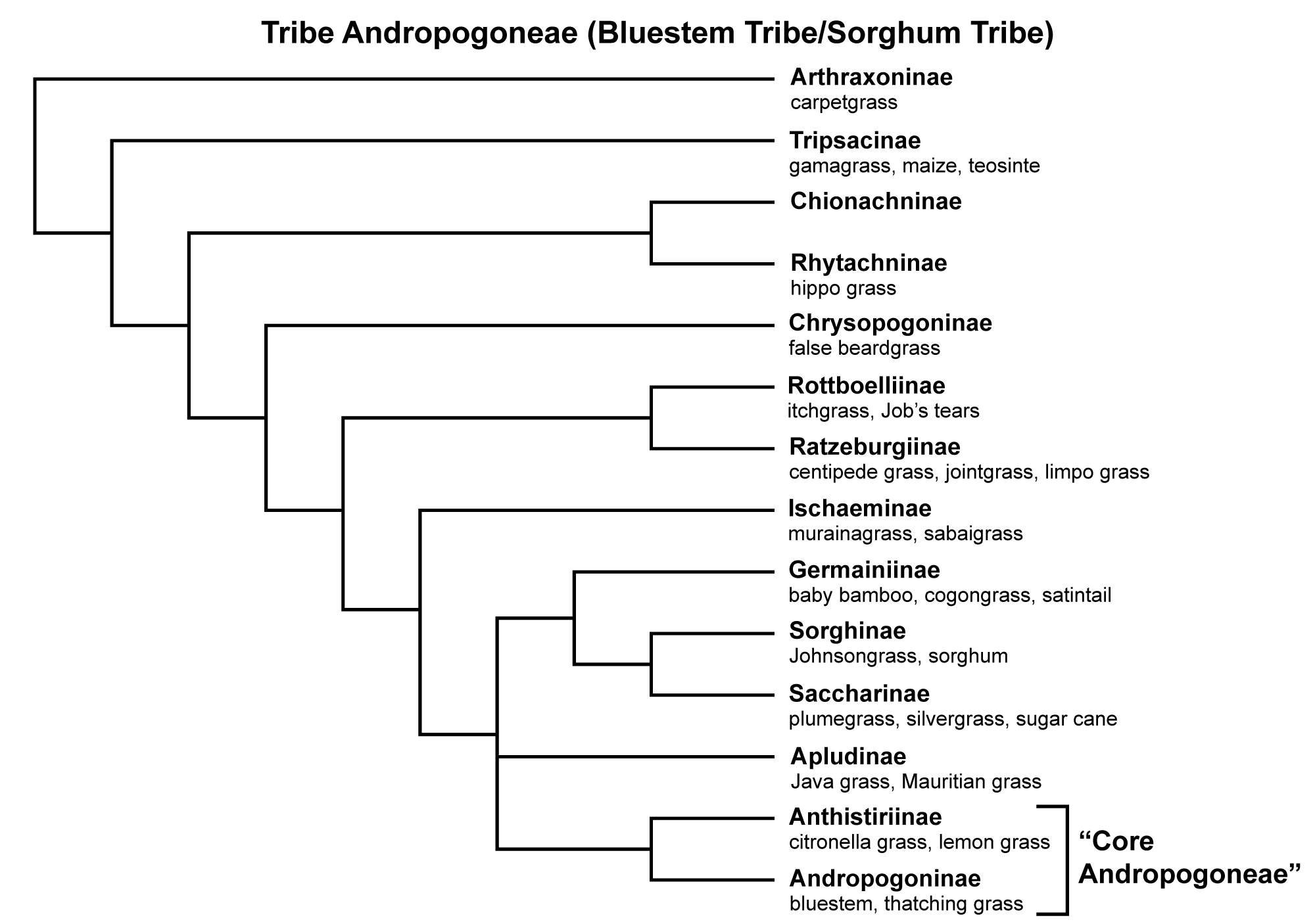
Relationships among the 14 subtribes in tribe Andropogoneae; genera not placed to a subtribe are not shown on this tree. This tree is adapted from Welker et al. (2020).
Subtribe Arthraxoninae
Subtribe Arthraxoninae includes only carpetgrass (Arthraxon), which has about seven species. This genus is widespread, occurring naturally in Africa, Australia, and Eurasia. It is introduced in Central and North America.
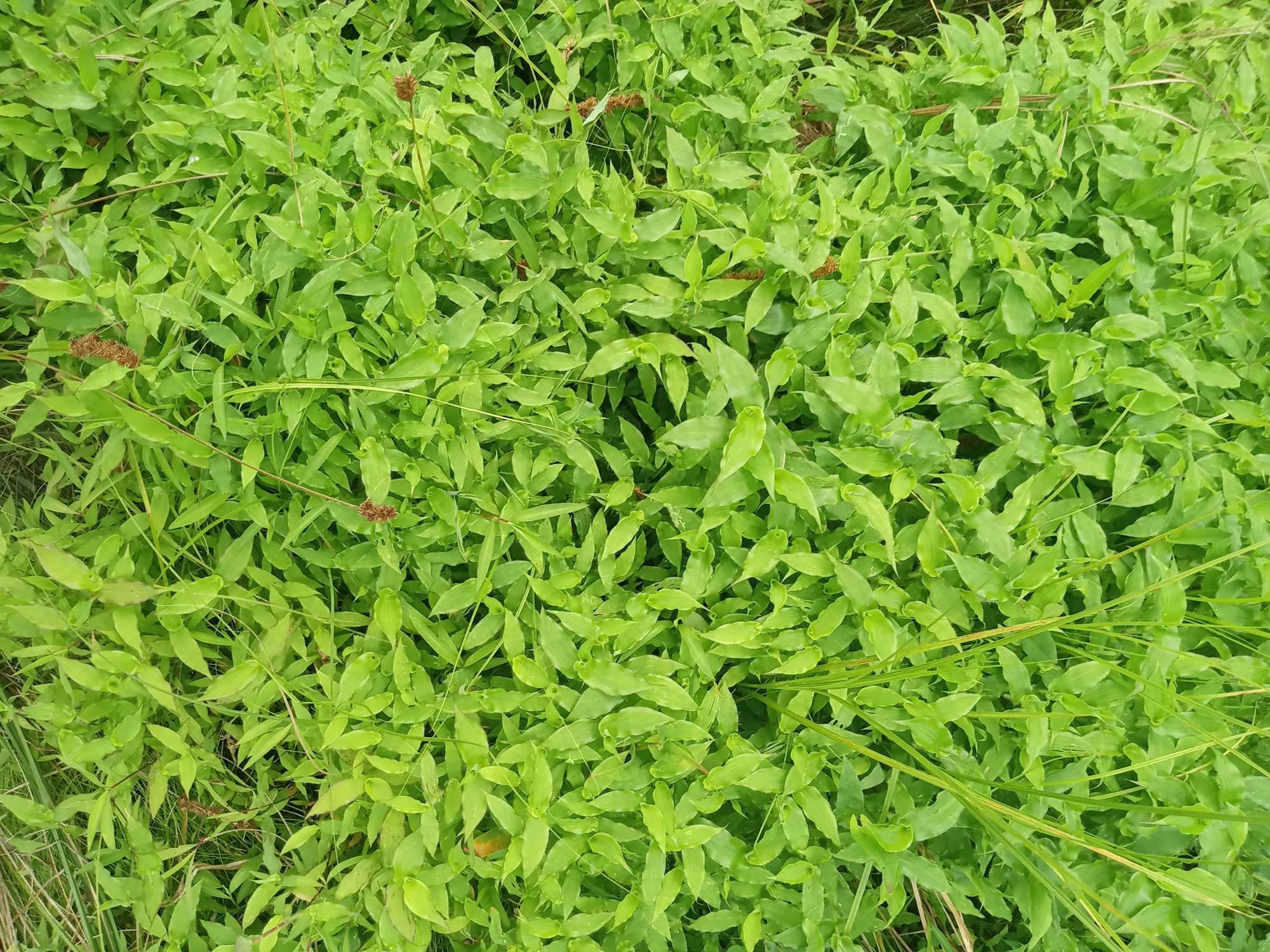
Small carpetgrass (Arthraxon hispidus), Bethel, Pennsylvania, U.S.A. Photo by Richard Gardner (iNaturalist, Creative Commons Attribution-NonCommercial 4.0 International license, image resized).
Subtribe Tripsacinae
Subtribe Tripsacinae has only two genera and more than 20 species. It includes gamagrass (Tripsacum), maize (Zea mays), and teosinte (several species of Zea), the wild relatives of maize. Subtribe Tripsacinae is the only subtribe of Andropogoneae native only to the Americas.
Maize is a widely grown cereal crop and is also used to produce biofuels (ethanol), sugar (high fructose corn syrup), corn starch, and other products. Eastern gamagrass (Tripsacum dactyloides) is cultivated as an ornamental.
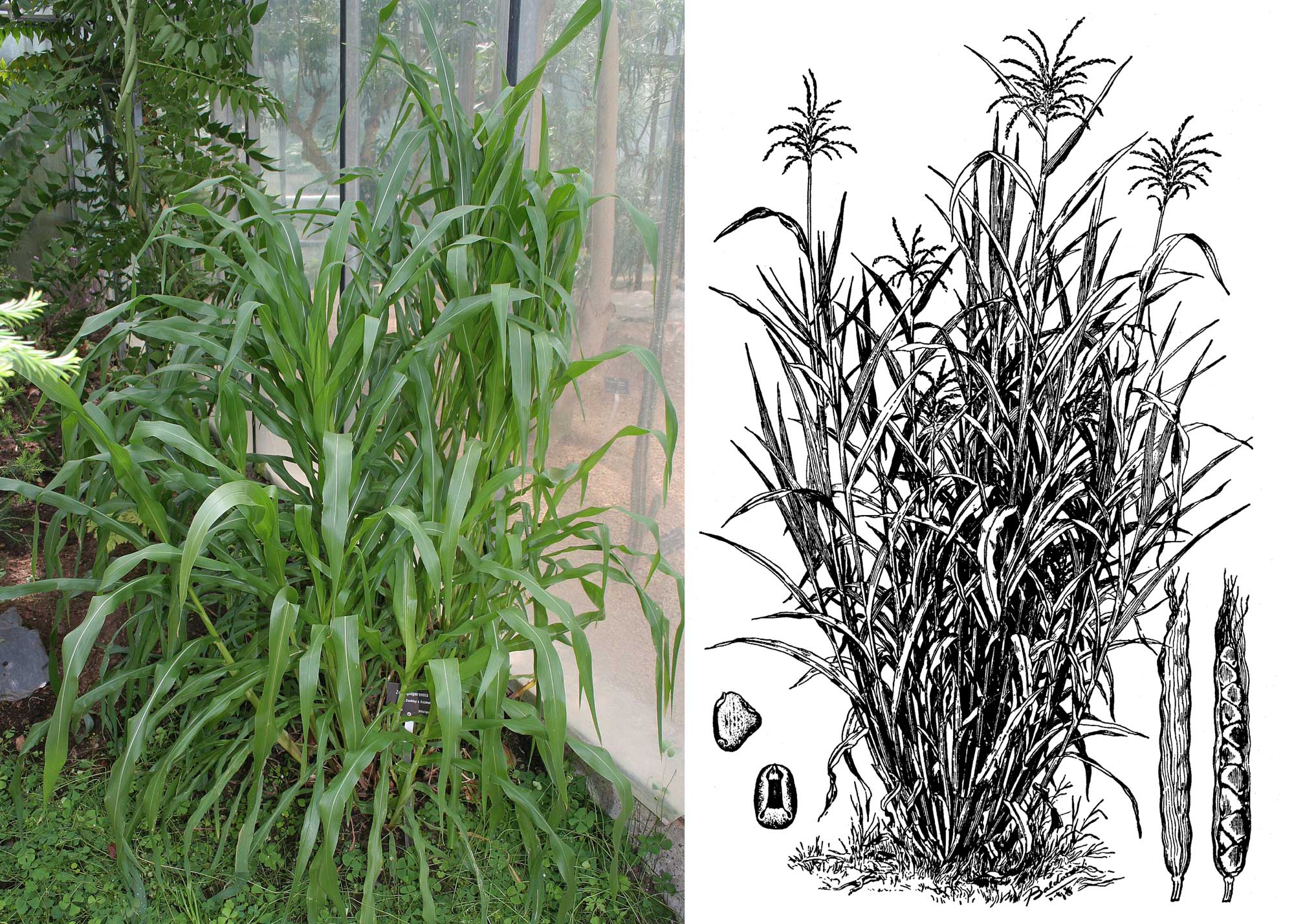
Teosinte plants. Left: Zea diploperennis. Right: Zea mays subspecies mexicana. Photo credits: Zea diploperennis by Jeffdelonge (Wikimedia Commons, Creative Commons Attribution-ShareAlike Unported license, image cropped and resized); Zea mays subspecies mexicana (Wikimedia Commons, via USDA PLANTS, public domain).
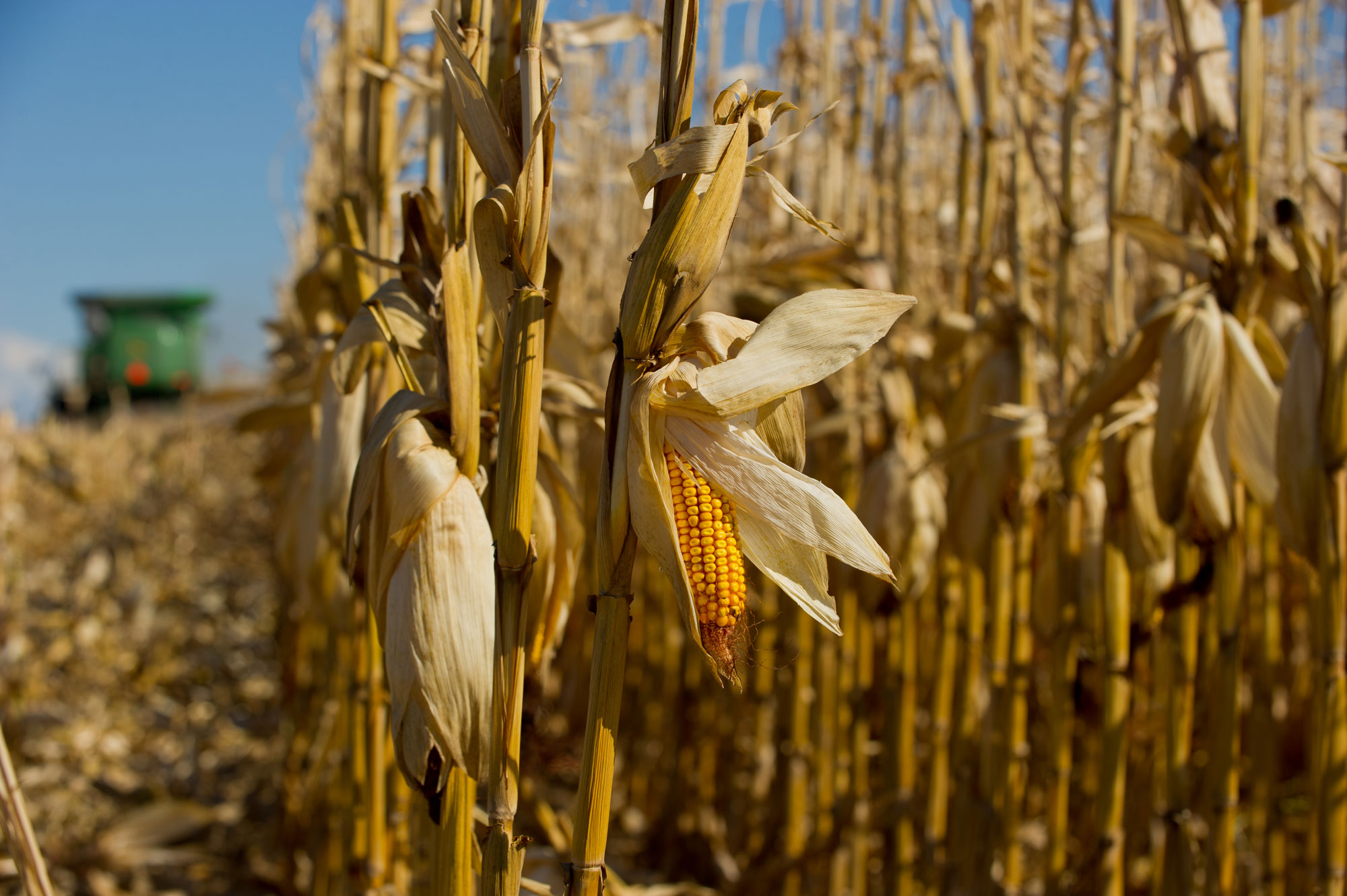
Corn (Zea mays) harvest. Photo by United Soybean Board (flickr, Creative Commons Attribution 2.0 Generic license, image resized).
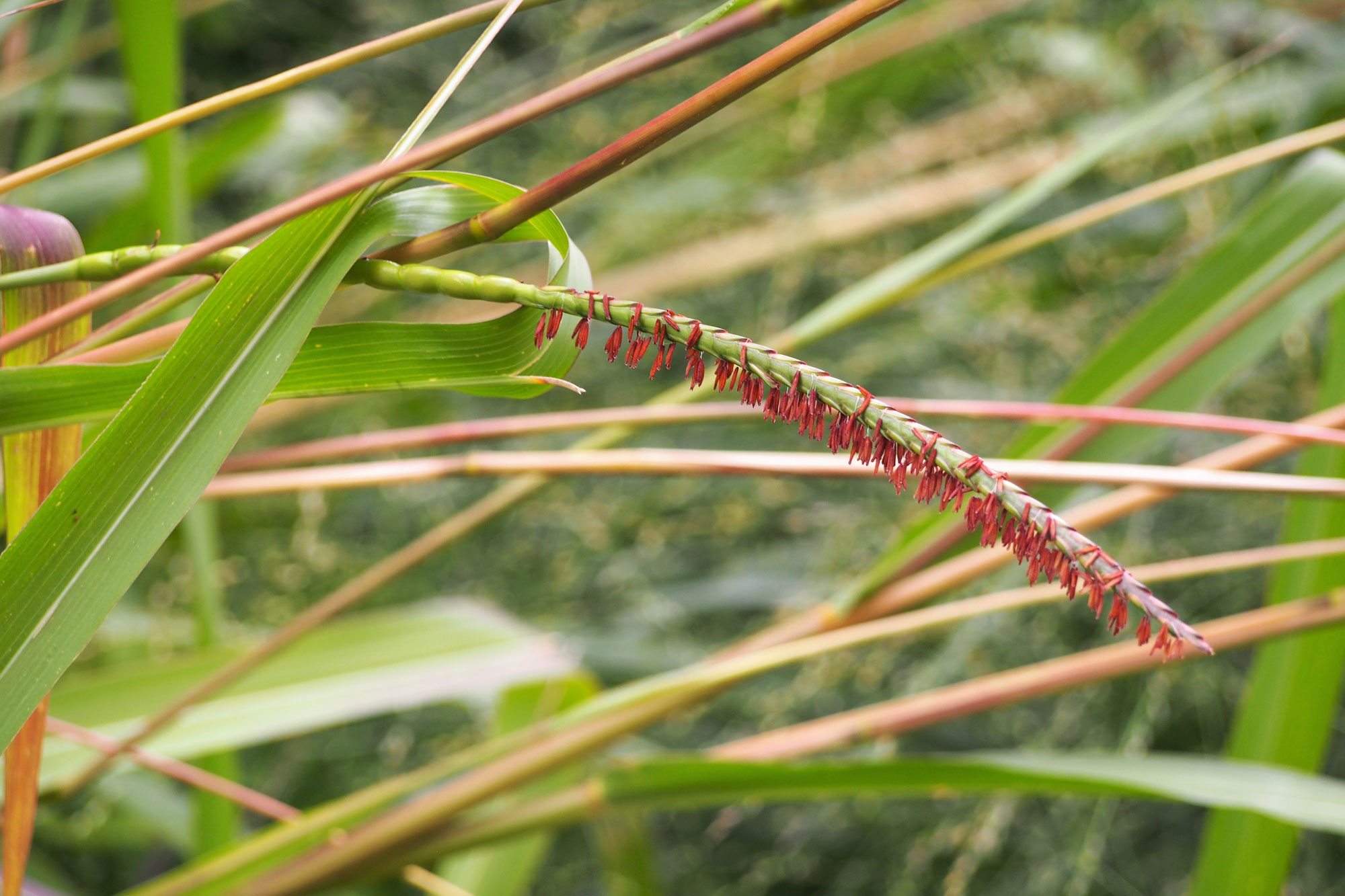
Inflorescence of eastern gamagrass (Tripsacum dactyloides); the red structures hanging down are anthers. Photo by Agnieska Kwiecień, Nova (Wikimedia Commons, Creative Commons Attribution-ShareAlike 4.0 International license).
Subtribe Chionachninae
Subtribe Chionanchninae includes three genera and about 12 species. Grasses in this subtribe occur in South Asia to Australia and are relatively rare.
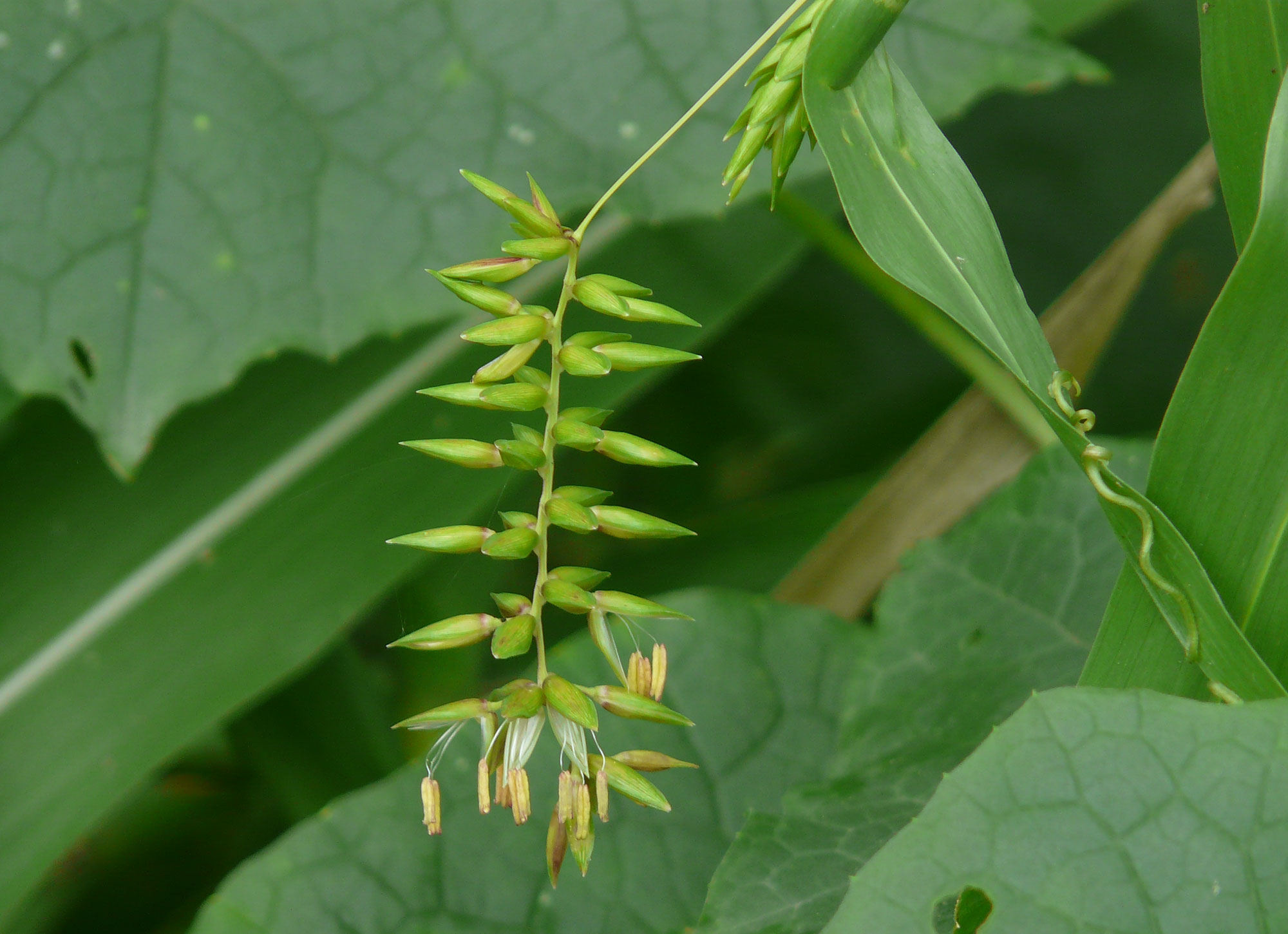
Inflorescence of giant Job's tears (Polytoca gigantea) with open male spikelets. Photo by Dinesh Valke (flickr, Creative Commons Attribution-ShareAlike 2.0 Generic license, image cropped and resized).
Subtribe Rhytachninae
Subtribe Rhytachninae includes five genera and about 26 species of tropical grasses. An example of a grass from Rhytachninae is hippo grass (Vossia cuspidata), which is native large parts of Africa and southeast Asia and grows in freshwater.
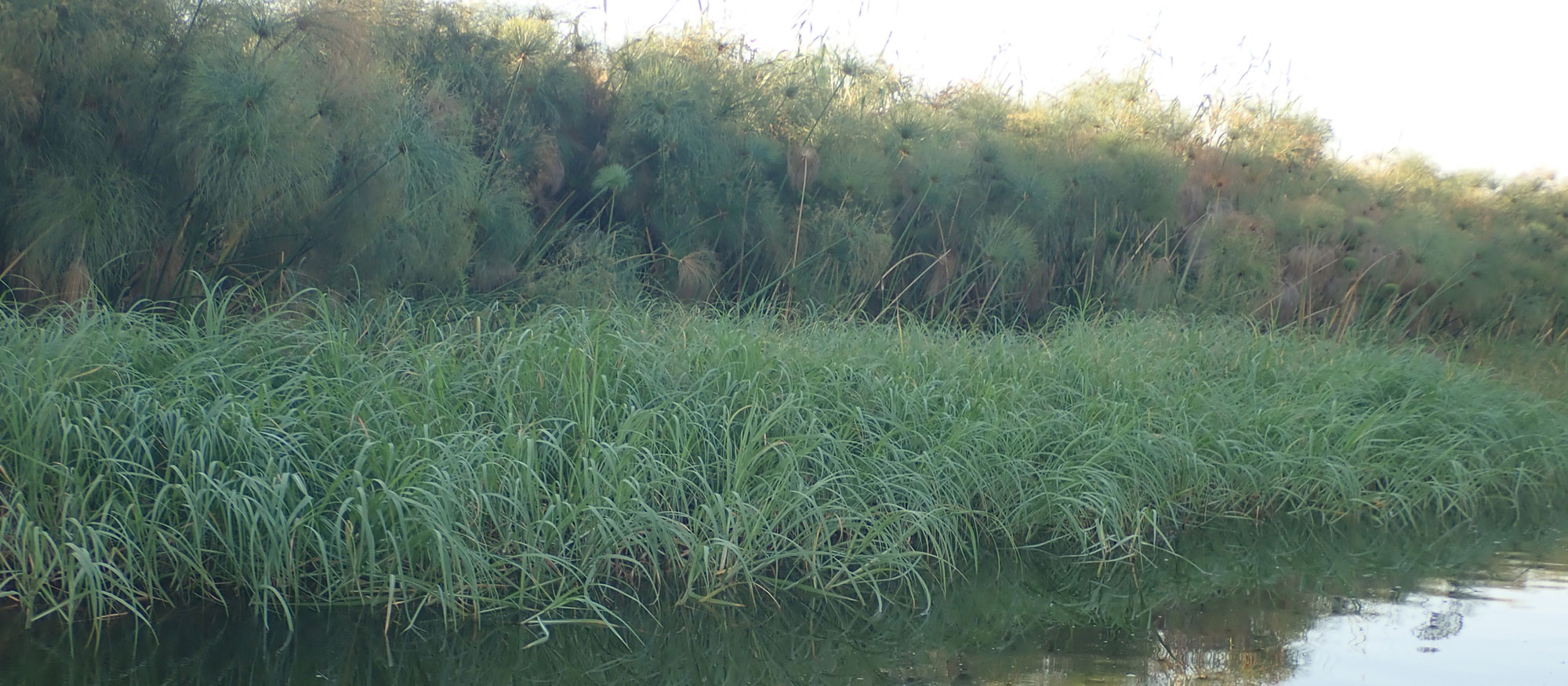
Hippo grass (Vossia cuspidata, foreground) and papyrus (Cyperus papyrus, a sedge, background) in Ngamiland North, Botswana. Photo by Robert Taylor (iNaturalist, Creative Commons Attribution 4.0 International license, image resized).
Subtribe Chrysopogoninae
Subtribe Chrysopogoninae includes one genus (false beardgrass, Chrysopogon) and about 50 species of warm temperate to tropical grasses. Most species are found in Africa, Asia, and Australia.
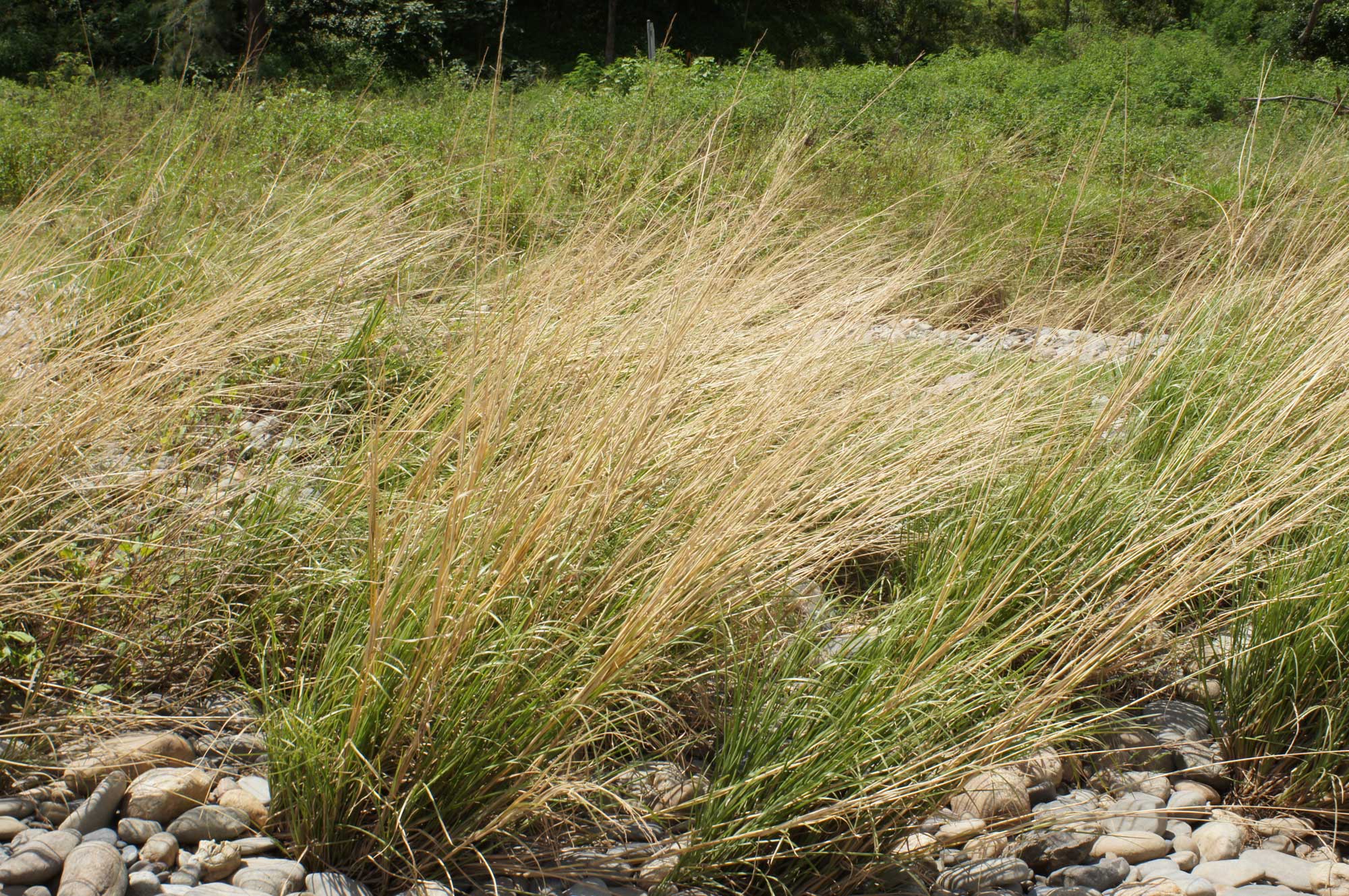
Chrysopogon filipes, Macleay River, New South Wales, Australia. Photo by Harry Rose (flickr, Creative Commons Attribution 2.0 Generic license, image resized).
Subtribe Rottboelliinae
Subtribe Rottboellinae includes three genera and about 13 species. These grasses are native to Africa, Asia, and Australia.
Job's tears (Coix lachryma-jobi) has been widely introduced outside of its native range and is used in herbal medicine and as a grain in some parts of the world. Itchgrass or raoulgrass (Rottboellia cochinchinensis), which is now also widely distributed outside of its native range, is a roadside and agricultural weed, infesting fields of corn, cotton, peanuts, soybean, and sugarcane.
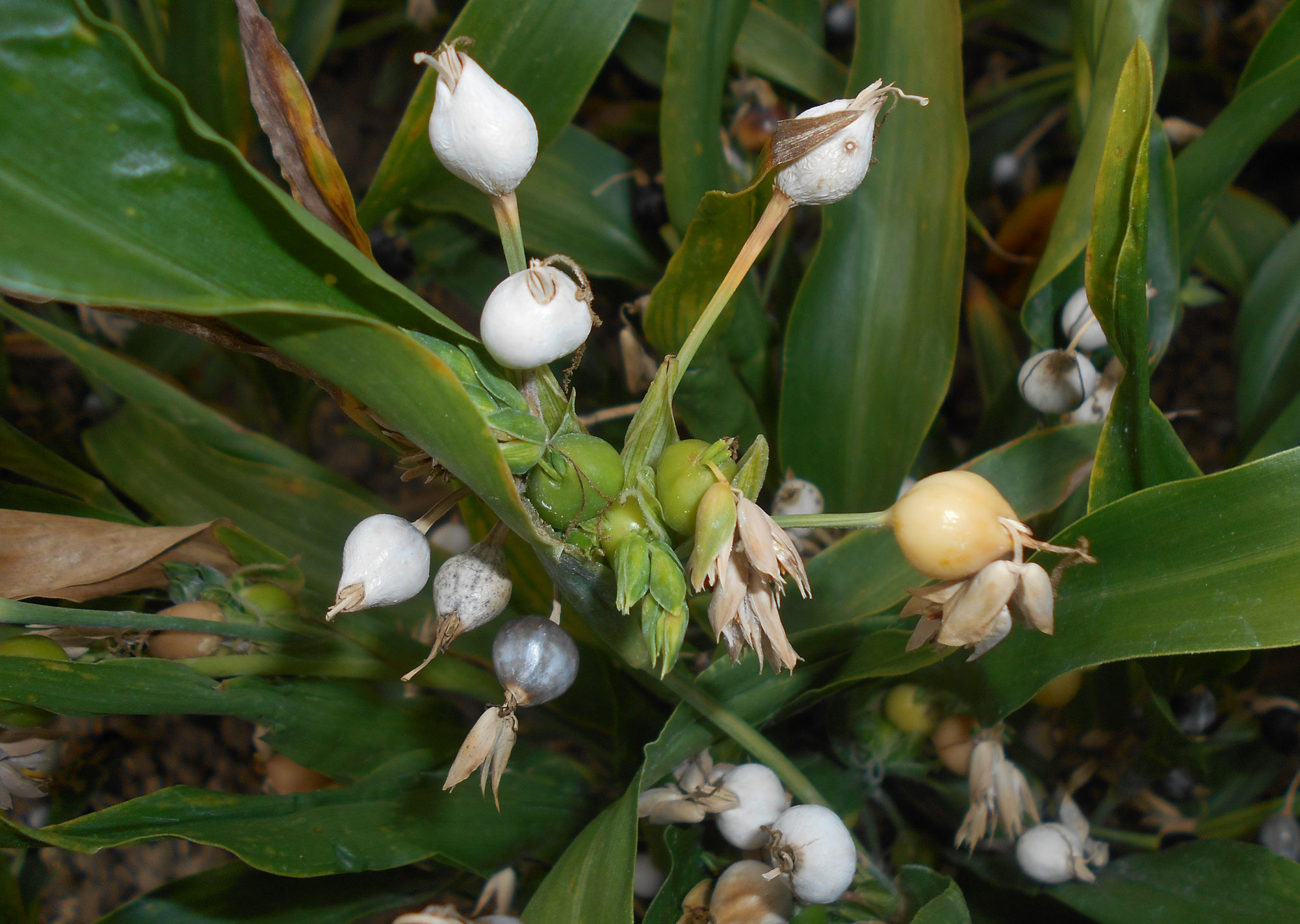
Job's tears (Coix lachryma-jobi), cultivated, Poland. Photo by Salicyna (Wikimedia Commons, Creative Commons Attribution-ShareAlike 4.0 International license, image cropped and resized).
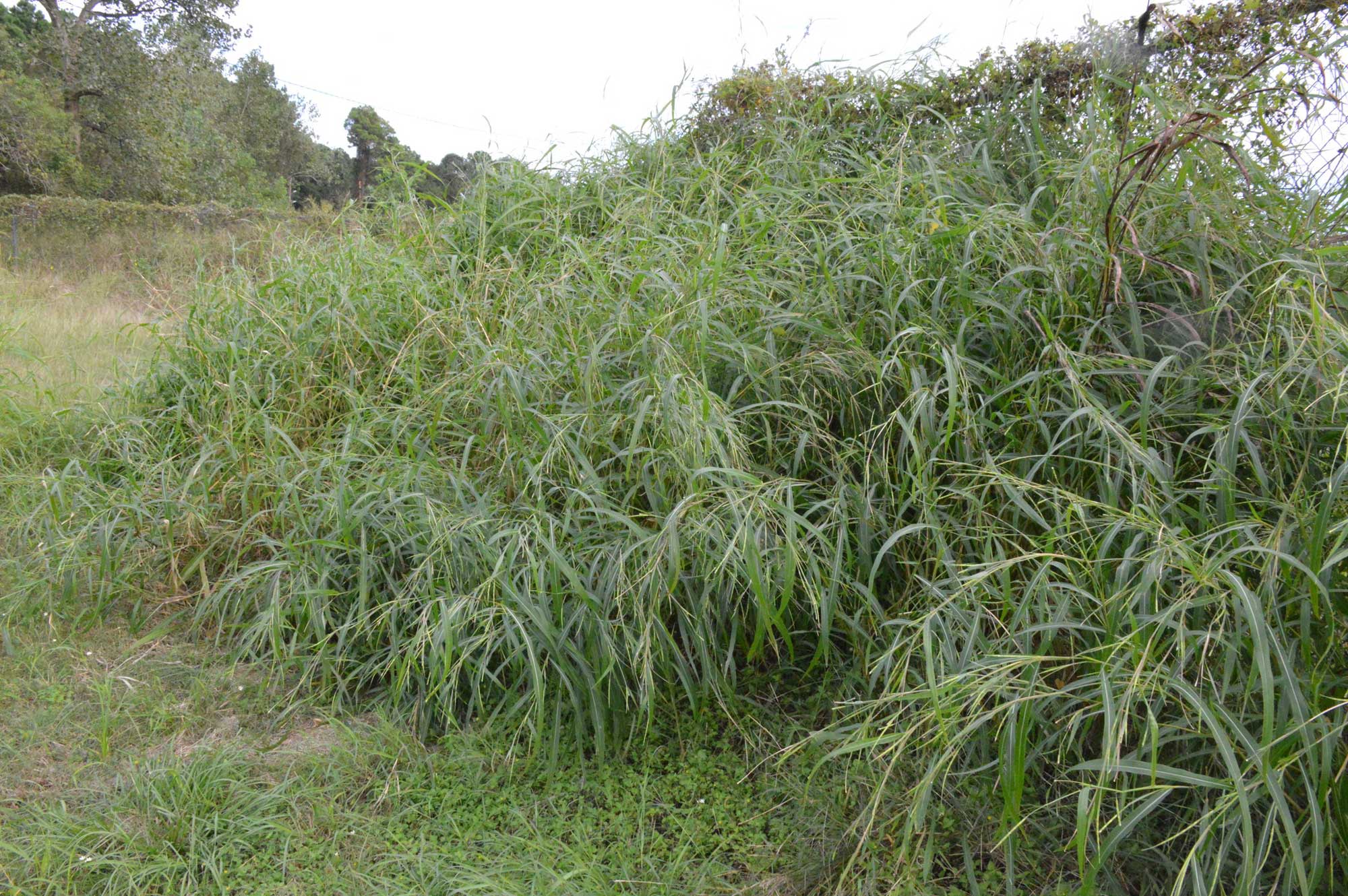
Itchgrass (Rottboellia cochinchinensis) in Houston, Texas, 2018. Photo by dan_johnson (iNaturalist, Creative Commons Attribution-NonCommercial 4.0 International license, image resized)
Subtribe Ratzeburgiinae
Subtribe Ratzenburgiinae includes 11 genera and nearly 90 species. Grasses in this subtribe are native to Africa, Asia, and Australia, and include centipede grass (Eremochloa), pitscale grass (Hackelochloa), jointgrass (Hemarthria), and jointtail grass (Mnesithea).
Limpo grass (Hemarthria altissima), native to Eurasia, is used as a tropical forage grass.
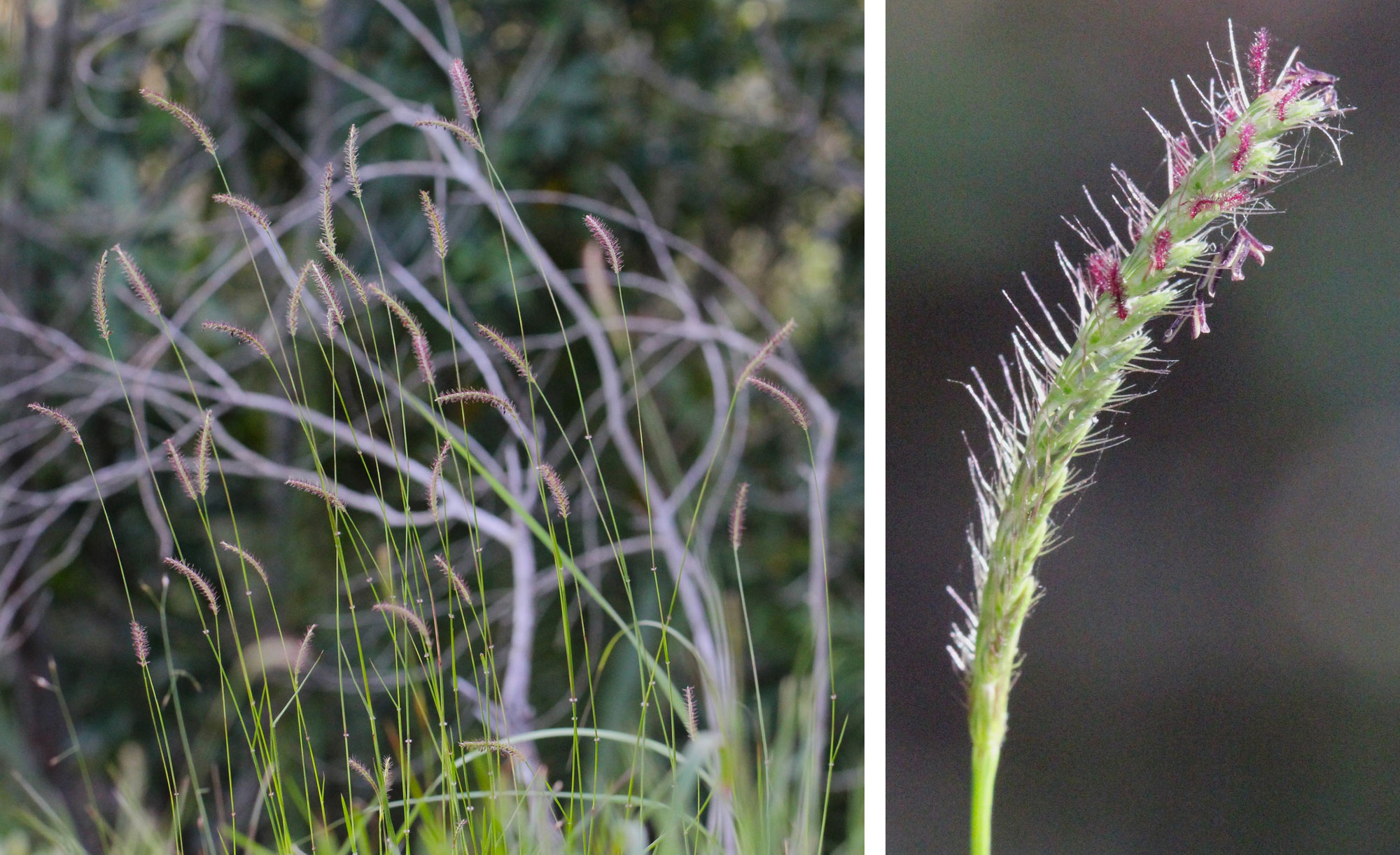
Fringed centipede grass (Eremochloa ciliaris), Sze Pai Shek Shan, China. Photo by agnestrekker (iNaturalist, CC0 1.0 Universal/public domain dedication).
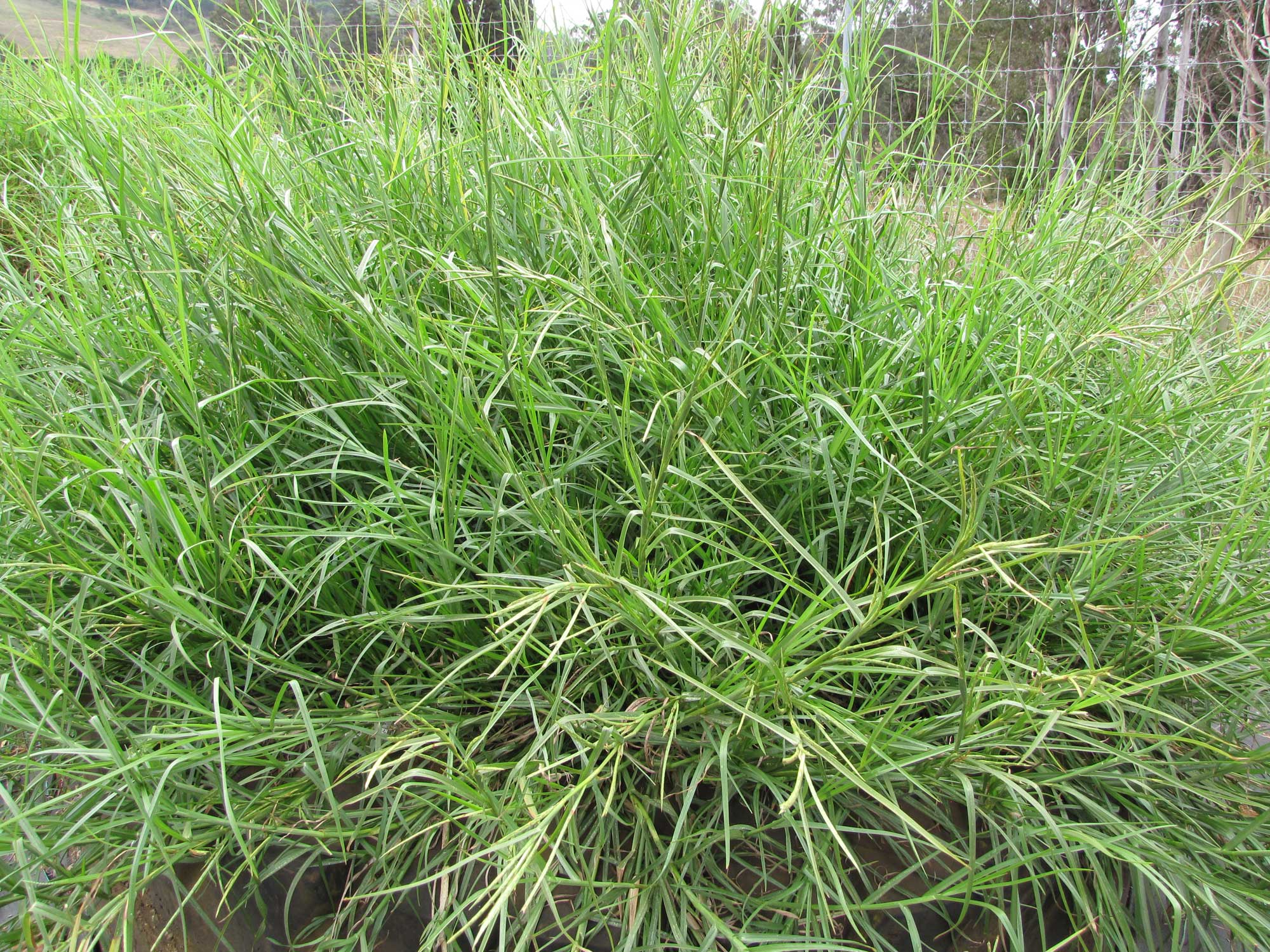
Limpo grass (Hemarthria altissima), Maui, Hawaii. Photo by Forest & Kim Starr (Wikimedia Commons, Creative Commons Attribution 3.0 United States license, image resized).
Subtribe Ischaeminae
Subtribe Ischaeminae has about four genera and 150 species native to the tropics worldwide. Examples of members of this subtribe include sabaigrass (Eulaliopsis) and murainagrass (Ischaemum).
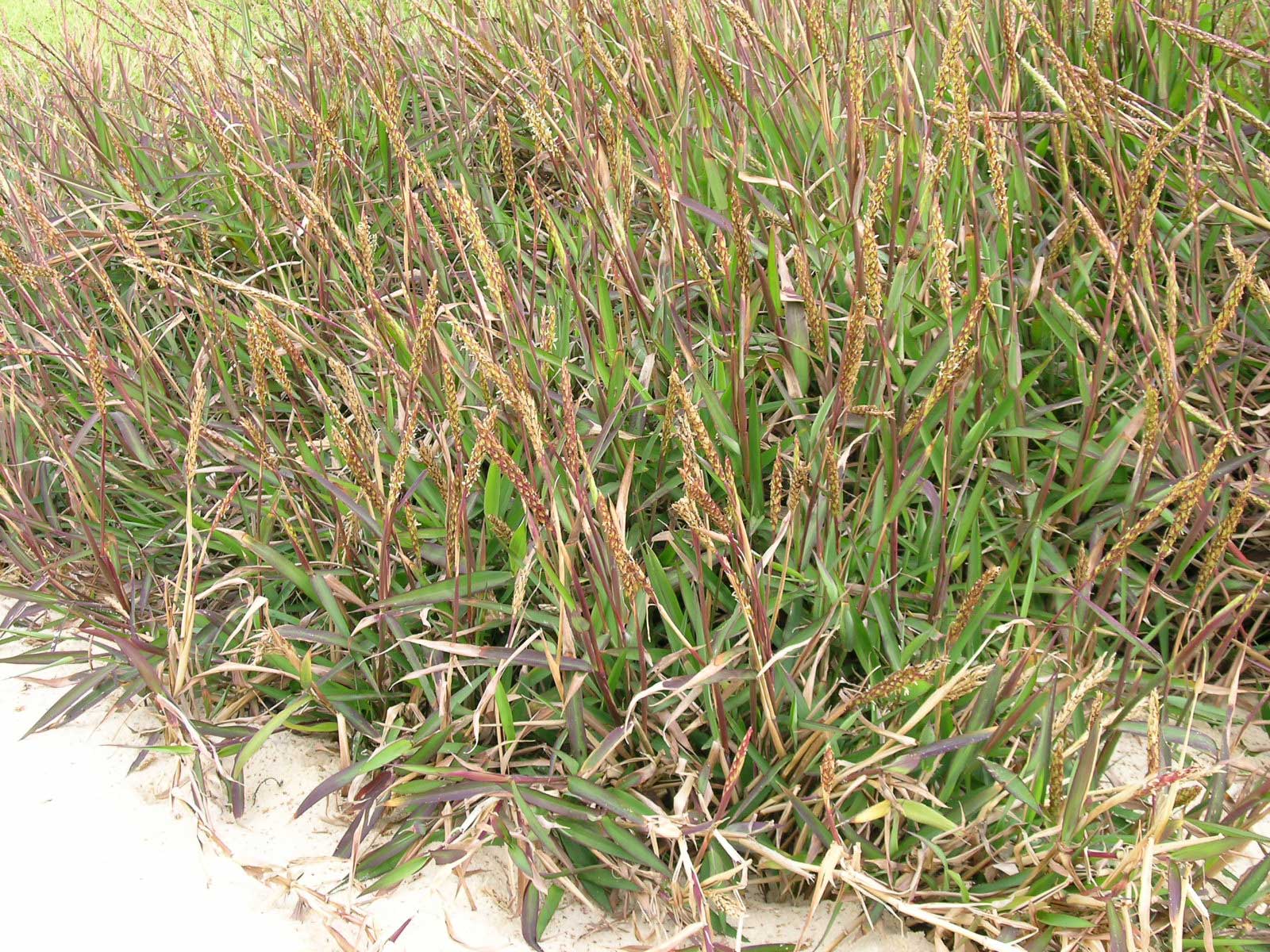
Ischaemum triticeum, Australia. Photo by Harry Rose (flickr, Creative Commons Attribution 2.0 Generic license, image resized).
Subtribe Germainiinae
Subtribe Germainiinae has five genera and 44 species. Four of the genera are native to Asia and Australia, whereas satintail (Imperata) is more widespread, found in the Americas, Africa, and Eurasia.
This subtribe includes cogongrass (Imperata cylindrica), a grass native to parts of Africa and Asia that is now a globally invasive weed. Nevertheless, one cultivar of cogongrass, Japanese blood grass (Imperata cylindrica 'Red Baron') is grown as an ornamental. Another ornamental grass, baby bamboo or baby panda grass (Pogonatherum paniceum), is also in this subtribe.

Cogongrass (Imperata cylindrica) in Gauteng, South Africa. Photo by JMK (Wikimedia Commons, Creative Commons Attribution-ShareAlike 4.0 International license, image resized).
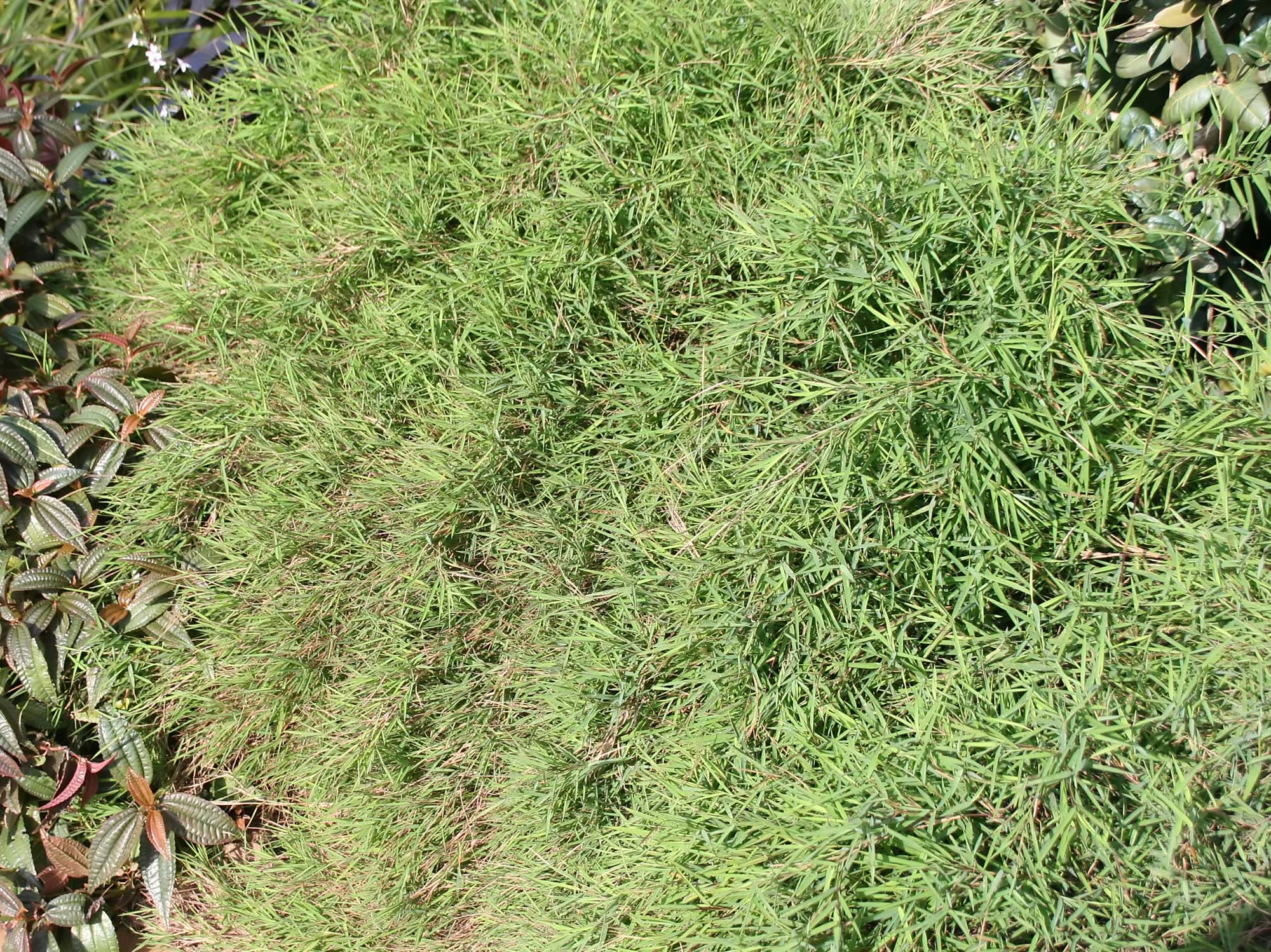
Baby bamboo (Pogonatherum paniceum, not a true bamboo), cultivated. Photo by David J. Stang (Wikimedia Commons, Creative Commons Attribution-ShareAlike 4.0 International license, image cropped and resized).
Subtribe Sorghinae
Subtribe Sorghinae has four genera and fewer than 40 species. The largest and most important genus is sorghum (Sorghum), which includes one of the world's major cereal crops (Sorghum bicolor). Johnsongrass (Sorghum halepense) is a weed that is found throughout much of the world.
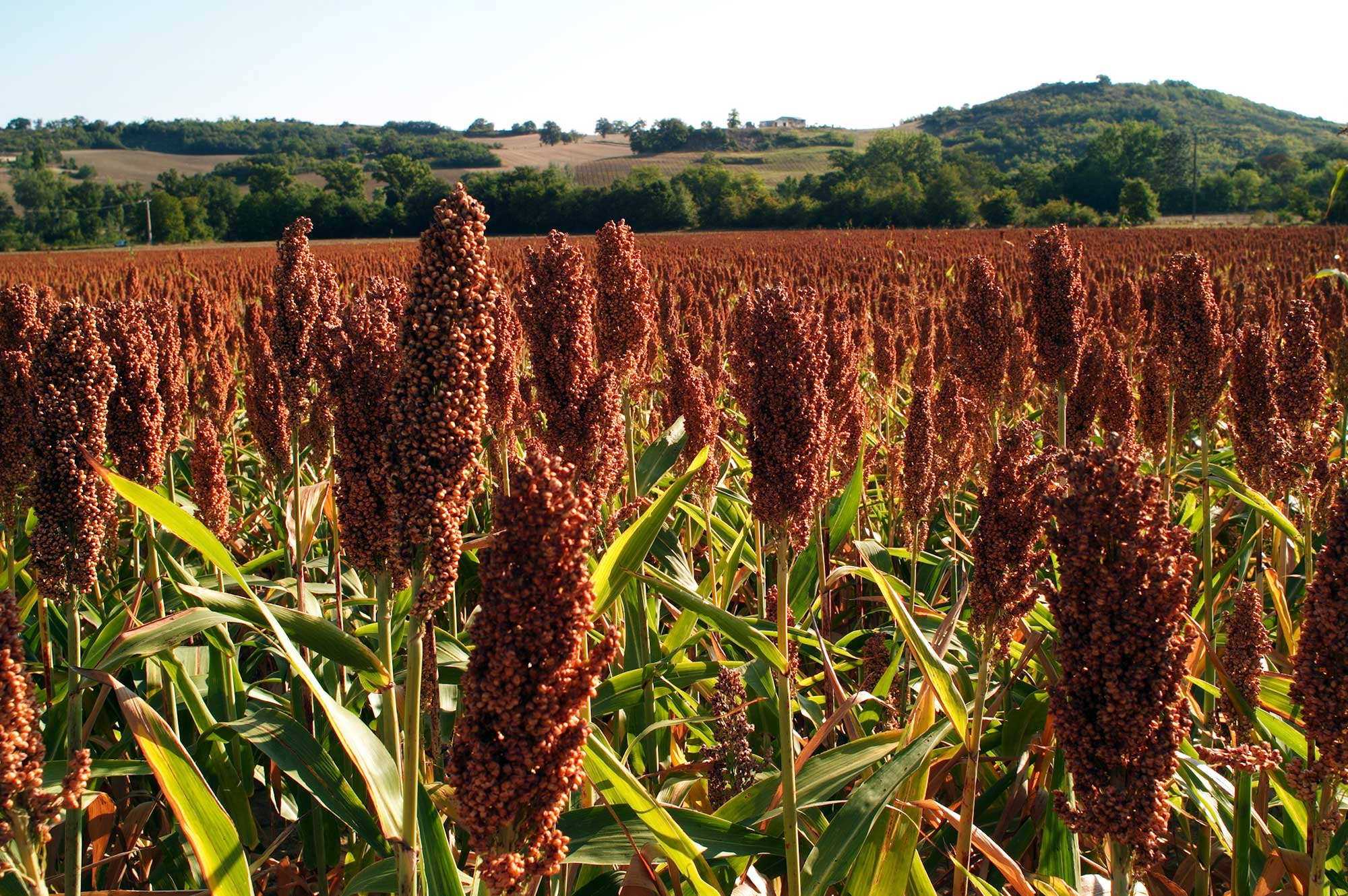
Cultivated sorghum (Sorghum bicolor), France. Photo by Jean Weber (flickr, Creative Commons Attribution 2.0 Generic license, image resized).

Johnsongrass (Sorghum halepense) growing in Missouri, U.S.A. Photo by florawhite (iNaturalist, Creative Commons Attribution 4.0 International license, image resized).
Subtribe Saccharinae
Subtribe Saccharinae has three genera and more than 60 species. These include silvergrass (Miscanthus), which is native to Africa, Asia, and Australia, and plumegrass (Saccharum), found throughout the tropics. The third genus, Pseudosorghum, is native to Asia.
Giant miscanthus (Miscanthus x giganteus) is a hybrid species that is grown for use as a biofuel. Some other species of silvergrass like Amur silvergrass (Miscanthus saccariflorus) and Chinese silvergrass (Miscanthus sinensis), are grown as ornamentals. At least one of these, Chinese silvergrass, is also weedy in some regions. Sugar cane (Saccharum officianarum), originally native to New Guinea, is now widely cultivated in the tropics as a source of sugar.
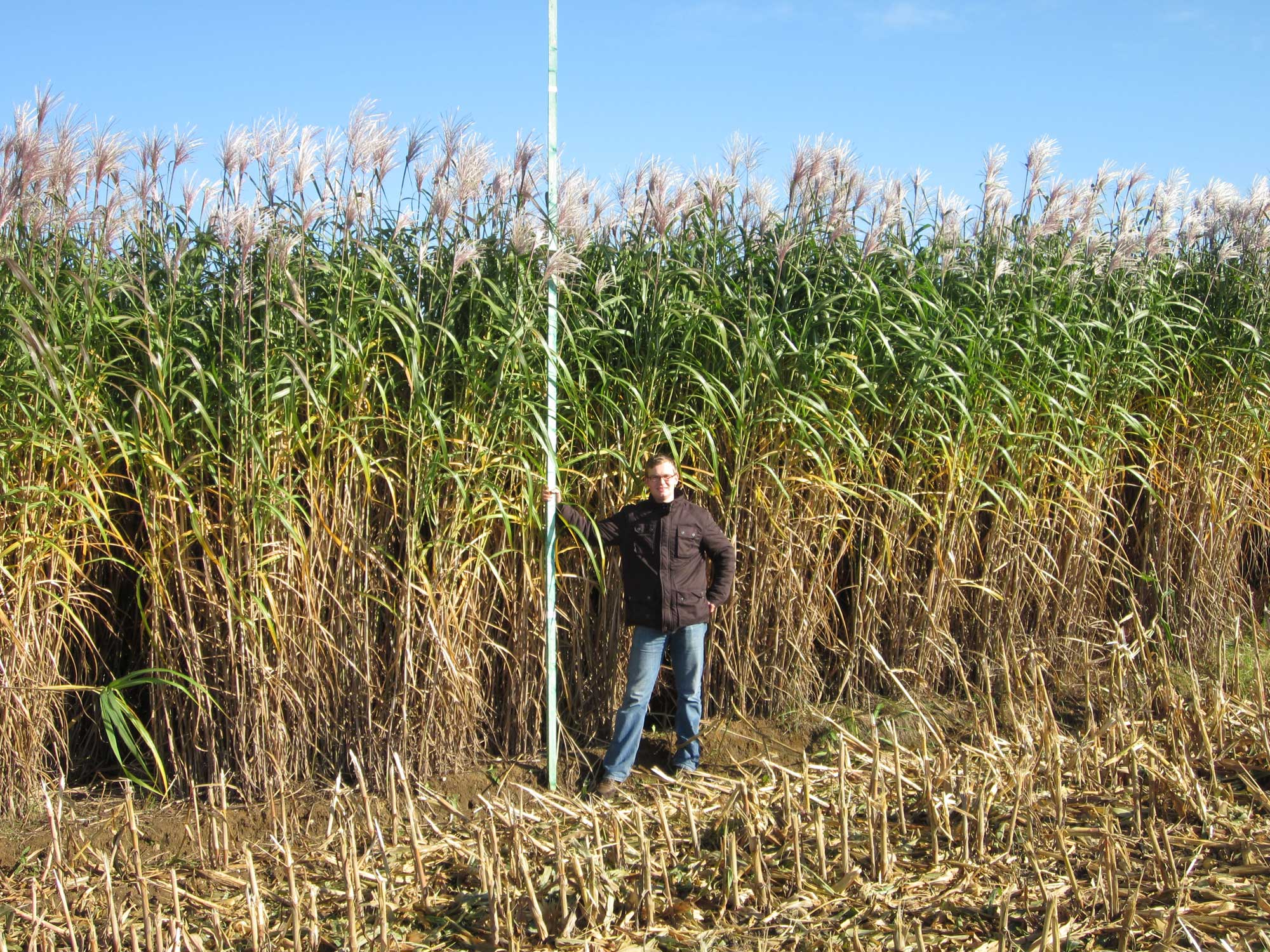
Giant miscanthus (Miscanthus x giganteus), cultivated in Germany. Photo by Hamsterdancer (Wikimedia Commons, Creative Commons Attribution-ShareAlike 3.0 Unported license, image resized).
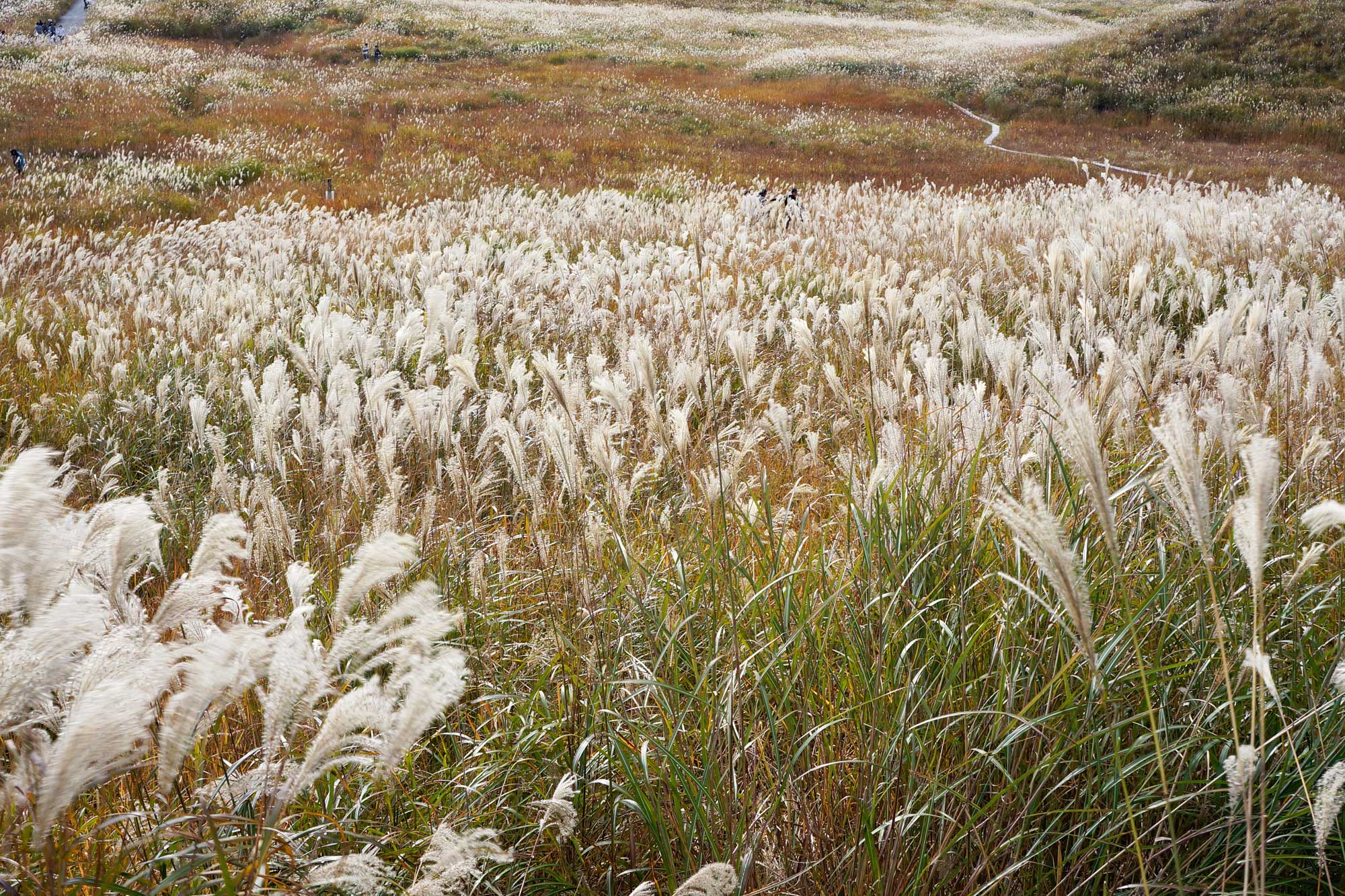
Chinese silvergrass (Miscanthus sinensis), Tonomine Highlands, Hyogo Prefecture, Honshu Island, Japan. Photo by 663highland (Wikimedia Commons, Creative Commons Attribution-ShareAlike 3.0 Unported license, image resized).
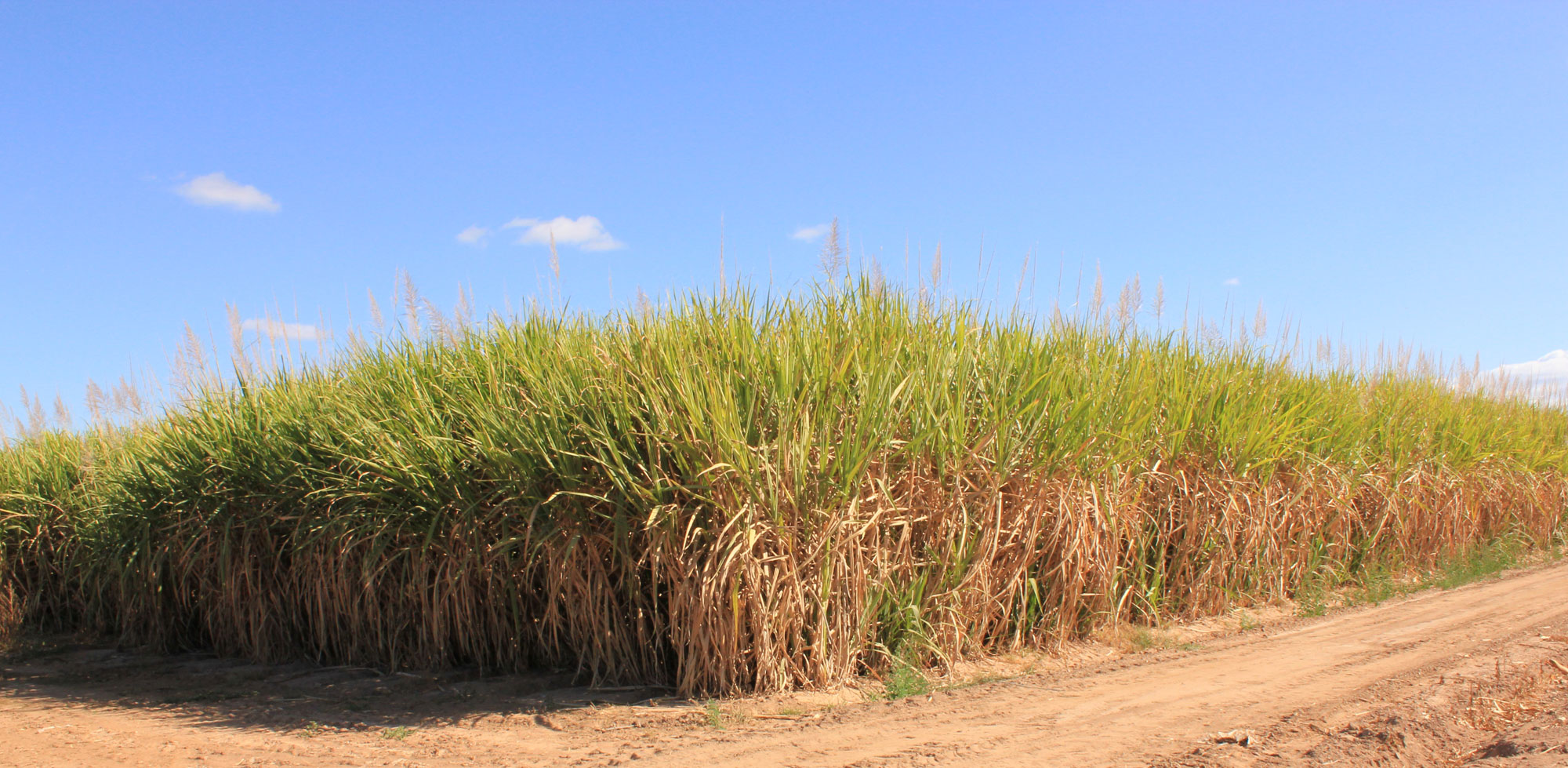
Field of sugar cane (Saccharum officianarum), Queensland, Australia. Photo by Richard Riley (flickr, Creative Commons Attribution 2.0 Generic license, image cropped and resized).
Subtribe Apludinae
Subtribe Apludineae has about seven genera and nearly 70 species and is found from tropical to temperate regions worldwide. Examples of members of this subtribe include Mauritian grass (Apluda), Java grass (Polytrias), Indiangrass (Sorghastrum), and crinkleawn grass (Trachypogon).
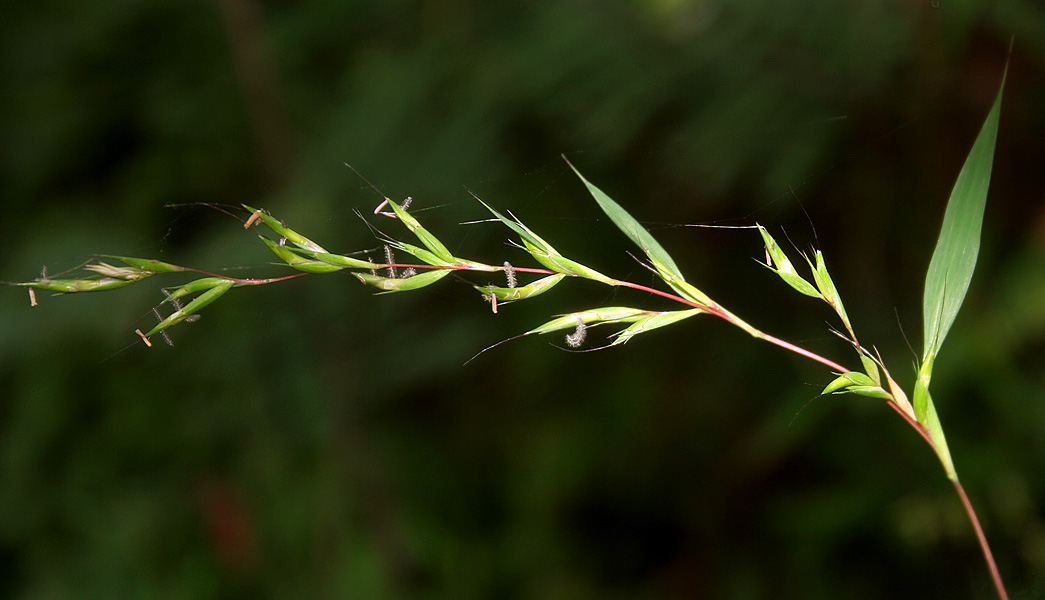
Mauritian grass (Apluda mutica), Andhra Pradesh, India. Photo by J.M.Garg (Wikimedia Commons, Creative Commons Attribution 3.0 Unported license, image resized).
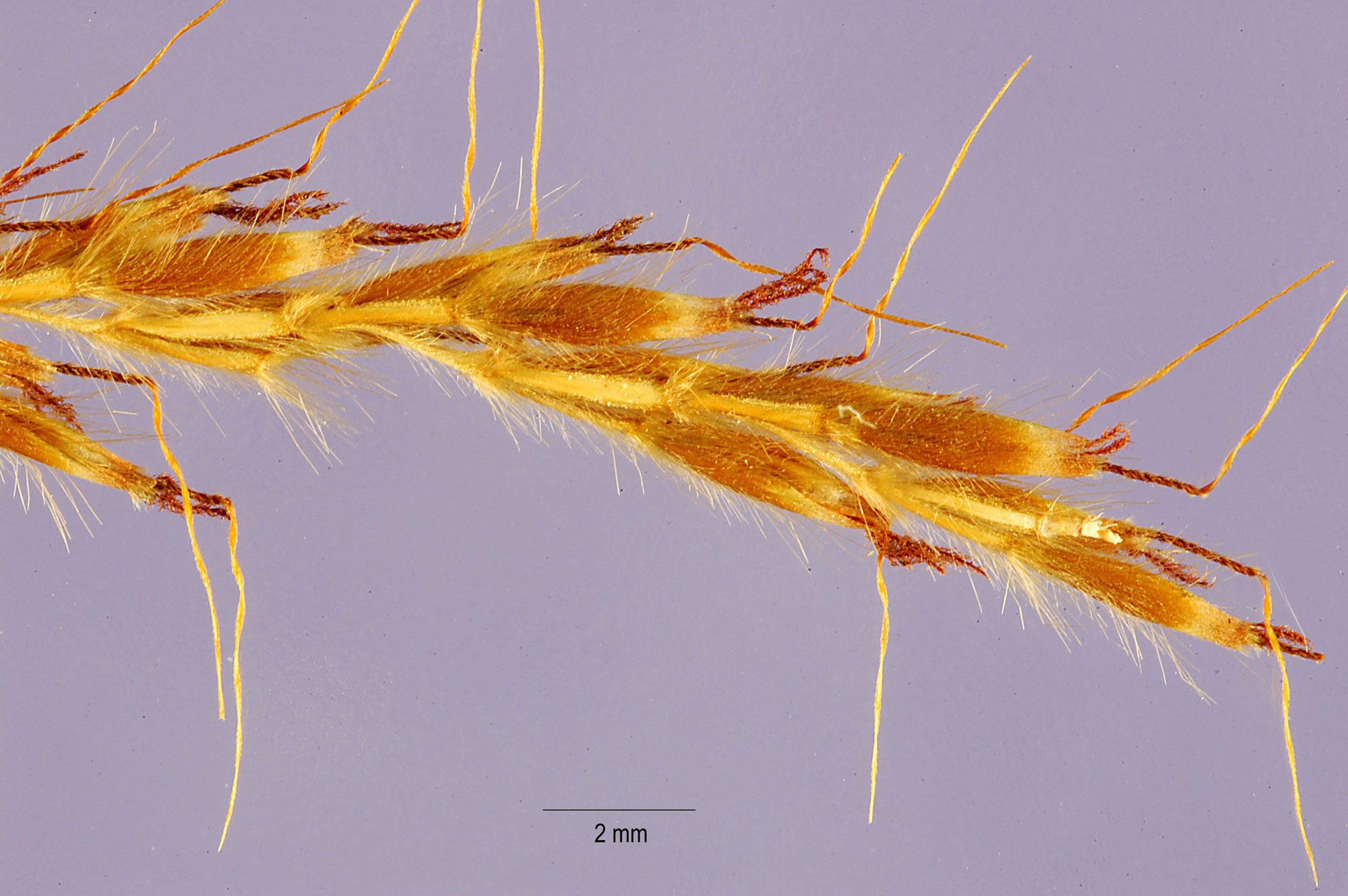
Inflorescence of Java grass (Polytrias indica), showing twisted awns. Photo by Tracey Slotta (USDA PLANTS via Wikimedia Commons, public domain).
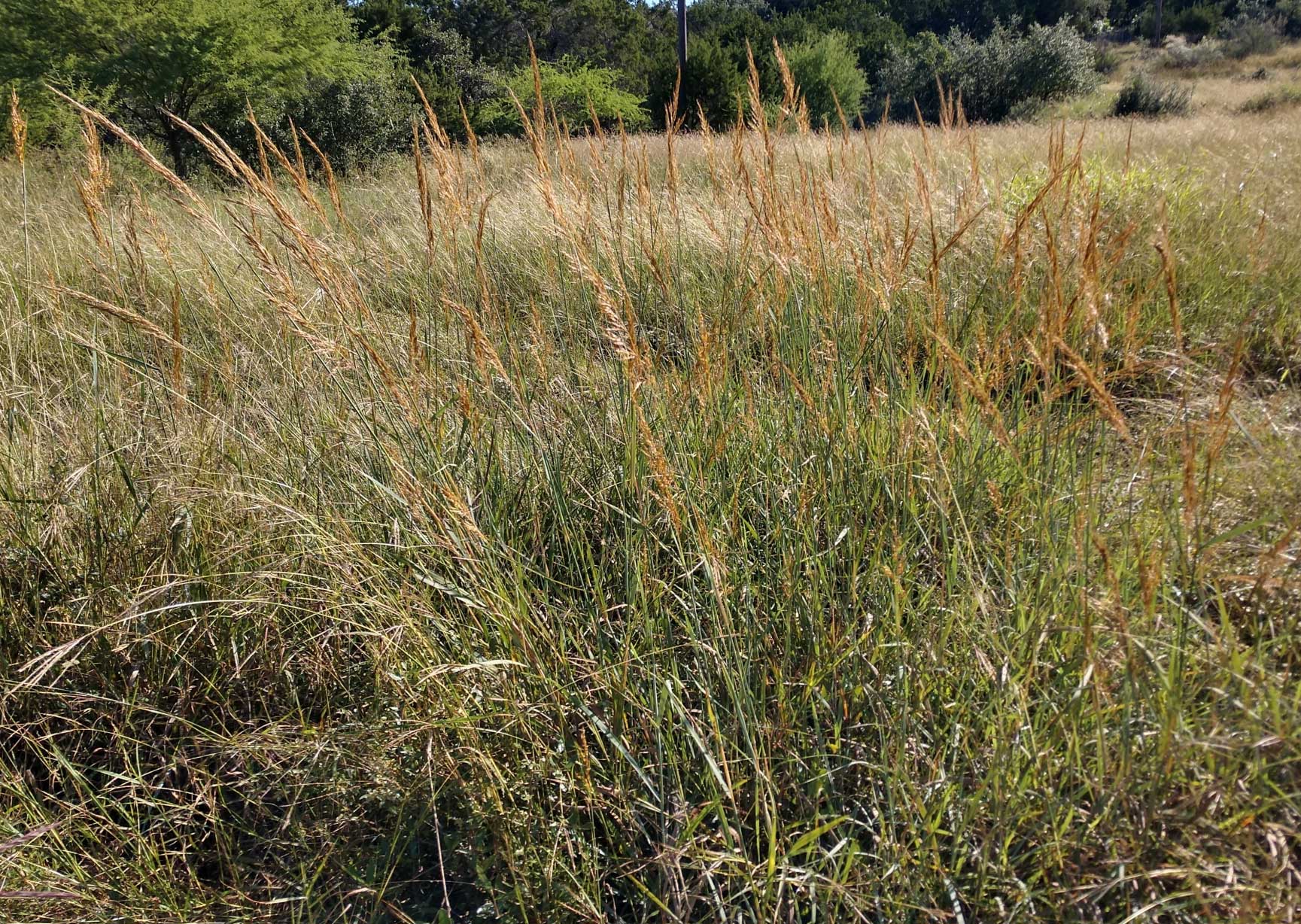
Indiangrass (Sorgahstrum nutans), San Antonio, Texas, U.S.A. Photo by prairie_rambler (iNaturalist, Creative Commons Attribution 4.0 International license, image cropped and resized).
Subtribe Anthistiriinae
Subtribe Anthistiriinae has nine genera and more than 200 species. These grasses are distributed around the world. Examples of grasses in this subtribe include beardgrass (Bothriochloa), bluestem (Dichanthium), mock bluestem (Euclasta), tanglehead (Heteropogon), and kangaroo grass (Themeda). Tanglehead and kangaroo grass are dominant grasses in some C4 grasslands, particularly in Africa, Asia, and South America.
This subtribe includes grasses like tanglehead (Heteropogon contortus), Caucasian bluestem (Bothriochloa bladhii), and yellow bluestem (Bothriochloa ischaemum) that are considered weeds in some regions where they have been introduced. Lemon grass (Cymbopogon citratus and C. flexuosus) is used to add flavor to food, and citronella grass (Cymbopogon nardus) is cultivated to produce citronella oil.

Kangaroo grass or red grass (Themeda triandra), Kruger National Park, South Africa. Photo by Bernard DuPont (flickr, Creative Commons Attribution-ShareAlike 2.0 Generic license, image resized).
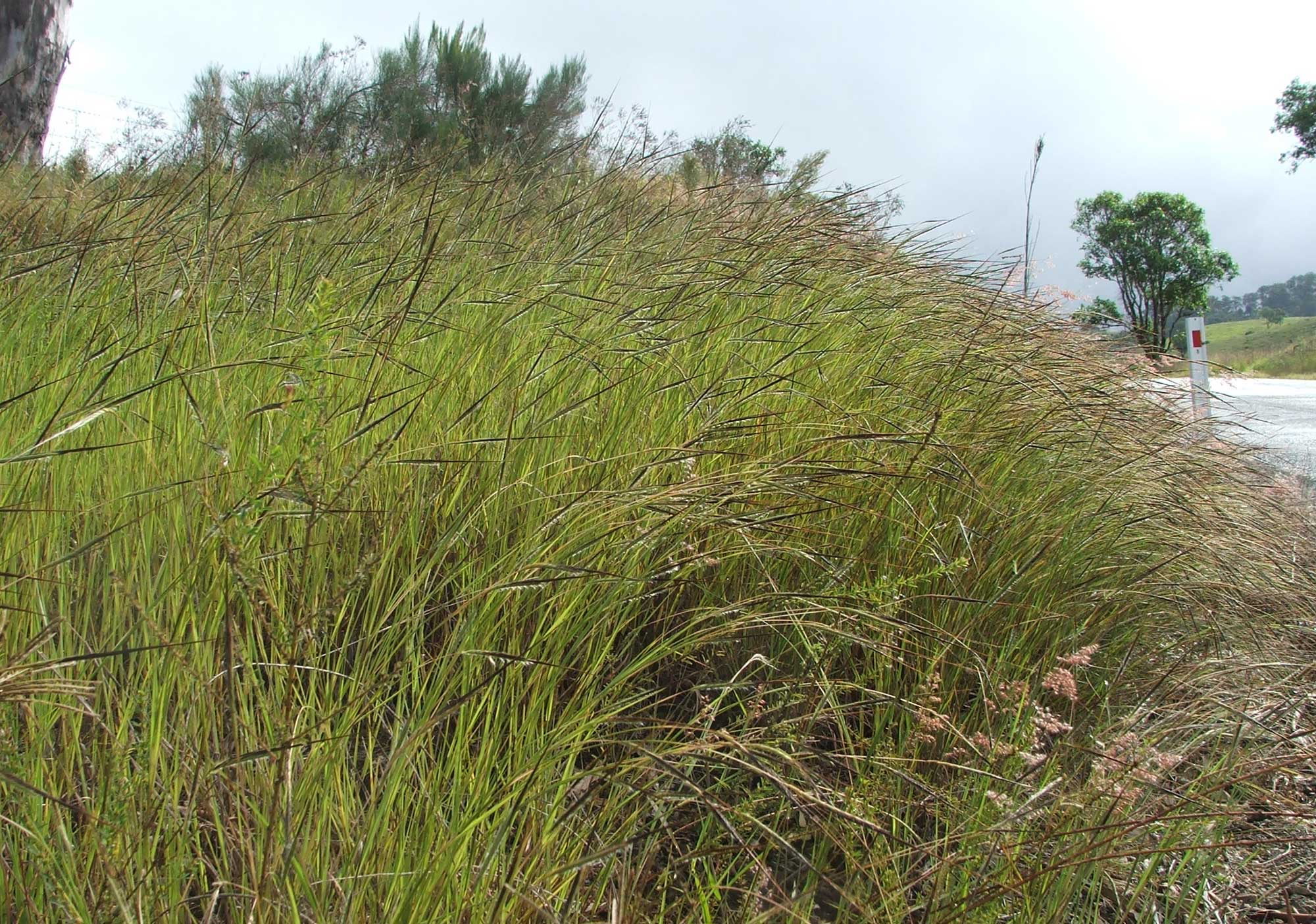
Tanglehead (Heteropogon contortus), Australia. Photo by Harry Rose (flickr, Creative Commons Attribution 2.0 Generic license, image cropped and resized).
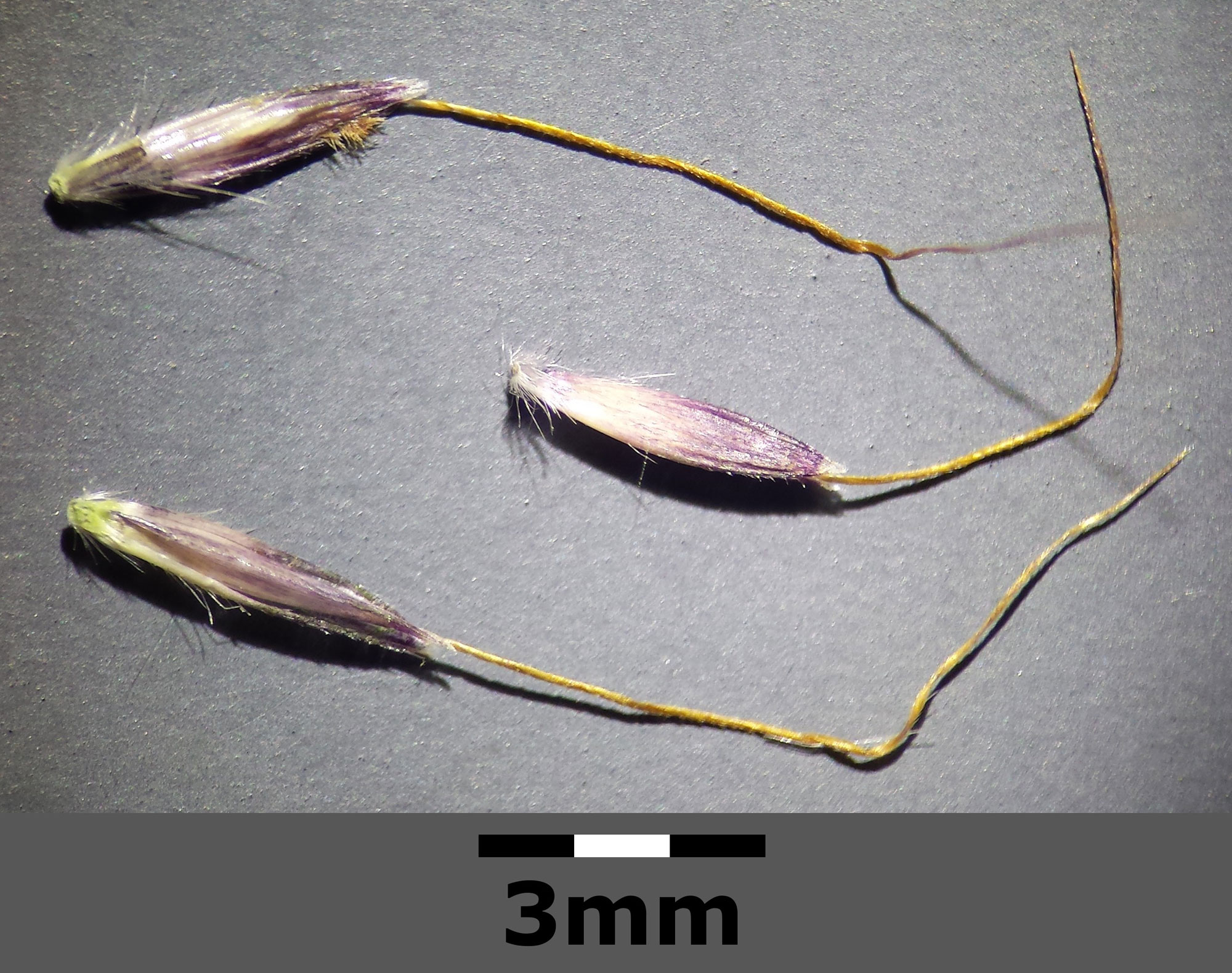
Spikelets of yellow bluestem (Bothriochloa ischaemum) showing long awns. Photo by Stefan.Iefnaer (Wikimedia Commons, Creative Commons Attribution-ShareAlike 4.0 International license, image resized).
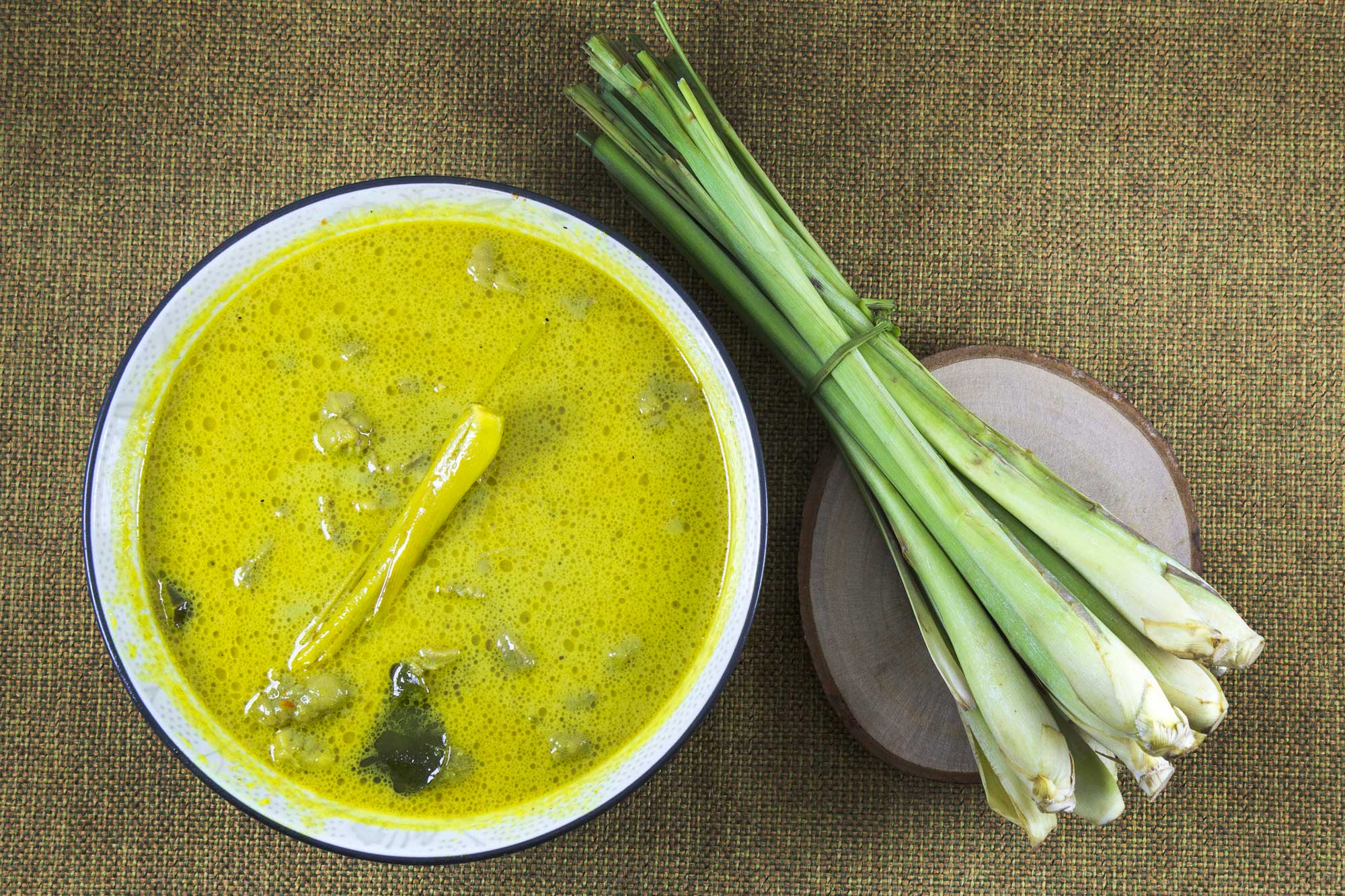
Lemongrass (Cymbopogon citratus) is used in cooking. Photo by Herusutimbul (Wikimedia, Creative Commons Attribution 4.0 International license, image resized).
Subtribe Andropogoninae
Subtribe Andropogoninae has eleven genera and about 290 species widely distributed around the world. Examples include bluestem (Andropogon), thatching grass (Hyparrhenia), and little bluestem (Schizachyrium).

Big bluestem (Andropogon gerardii) growing on a roadside in Minnesota, U.S.A. Photo by Matt Lavin (flickr, Creative Commons Attribution-ShareAlike 2.0 Generic license, image resized).

Thatching grass (Hyparrhenia hirta), Cáceres, Spain. Photo by Luis Fernández García (Wikimedia Commons, Creative Commons Attribution-ShareAlike 4.0 International license, image cropped and resized).
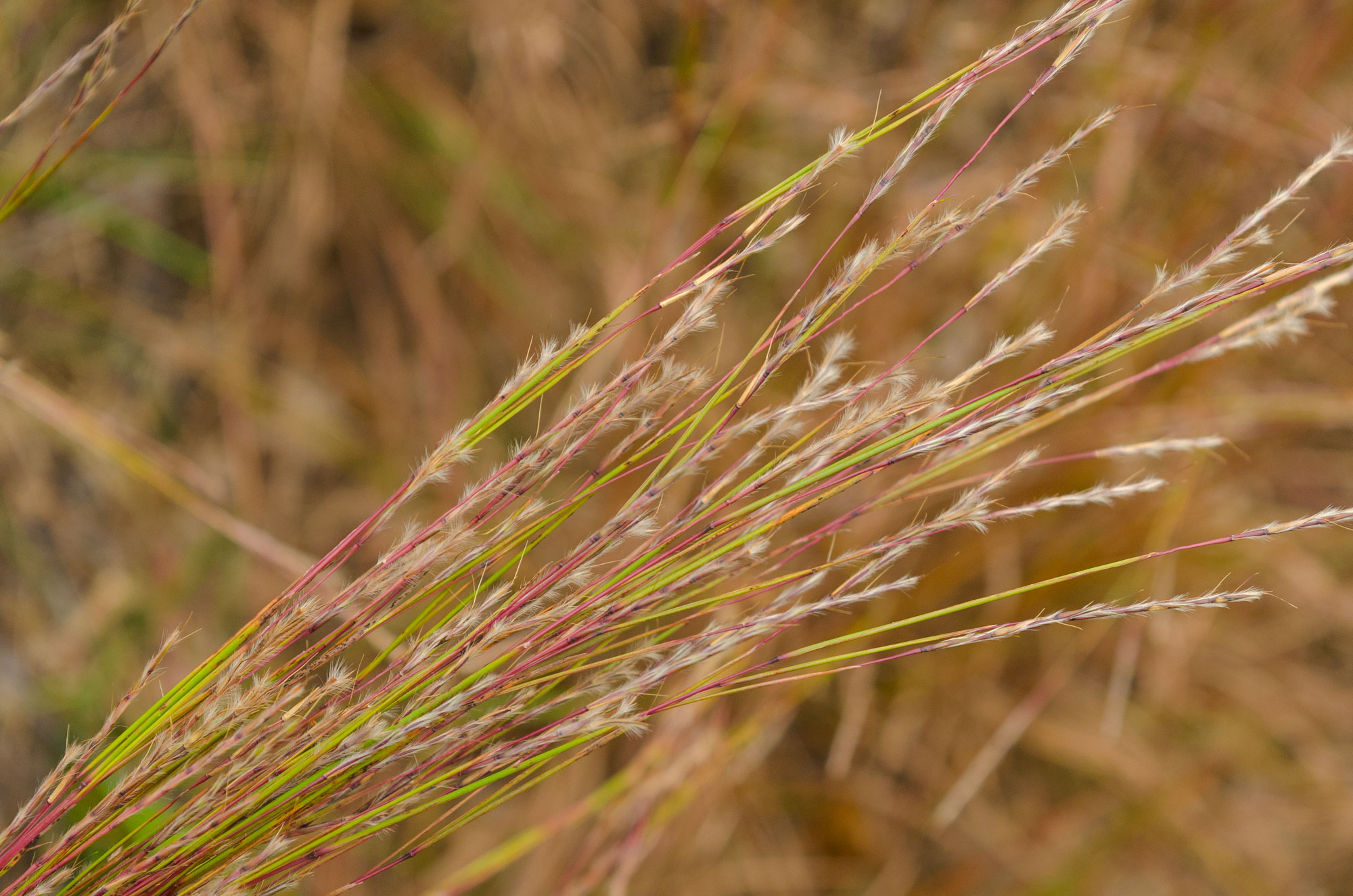
Little bluestem (Schizachyrium scoparium), Green County, Wisconsin, U.S.A. Photo by Joshua Mayer (flickr, Creative Commons Attribution-ShareAlike 2.0 Generic license, image resized).
Grasses not in a subtribe
Currently, 23 genera and about 125 species of grasses in tribe Andropogoneae have not yet been placed in a subtribe. Examples of these include balsamscale grass (Elionurus), moco de pavo (Eriochrysis), and browntop (Microstegium).
Japanese stiltgrass (Microstegium vimineum) is a grass native to Asia that is an invasive weed in forests of the eastern United States. Ravenna grass (Tripidium ravennae), native to Africa and Eurasia, is used as an ornamental in the U.S. but is also considered weedy. Frost grass (Spodiopogon sibiricus), native to eastern Asia, is used as an ornamental.
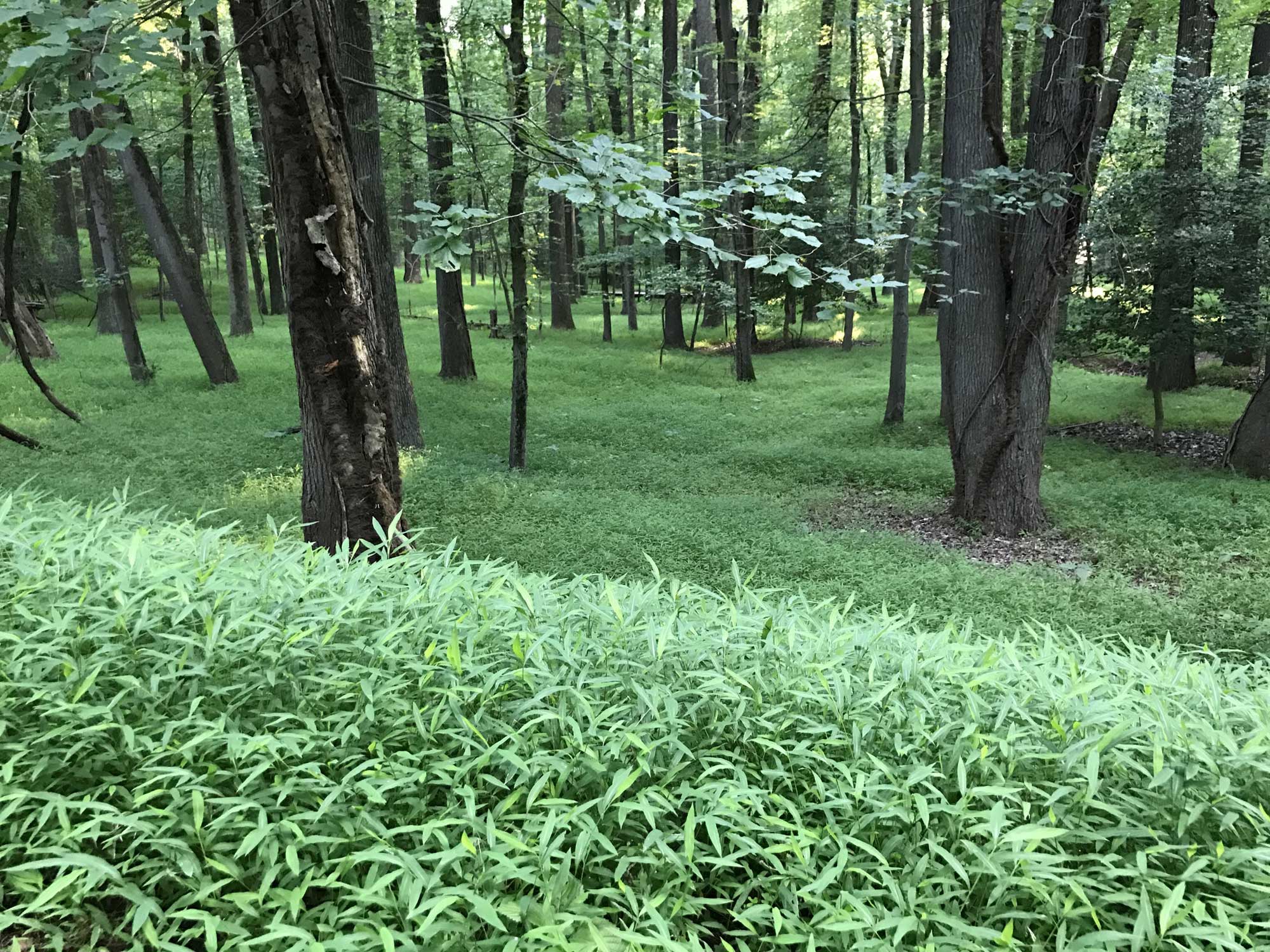
Carpet of Japanese stiltgrass (Microstegium vimineum) in Greenbelt Park, Maryland, U.S.A. This grass is considered an invasive weed in parts of the eastern U.S. Photo by mellis (iNaturalist, Creative Commons Attribution 4.0 International license, image resized).
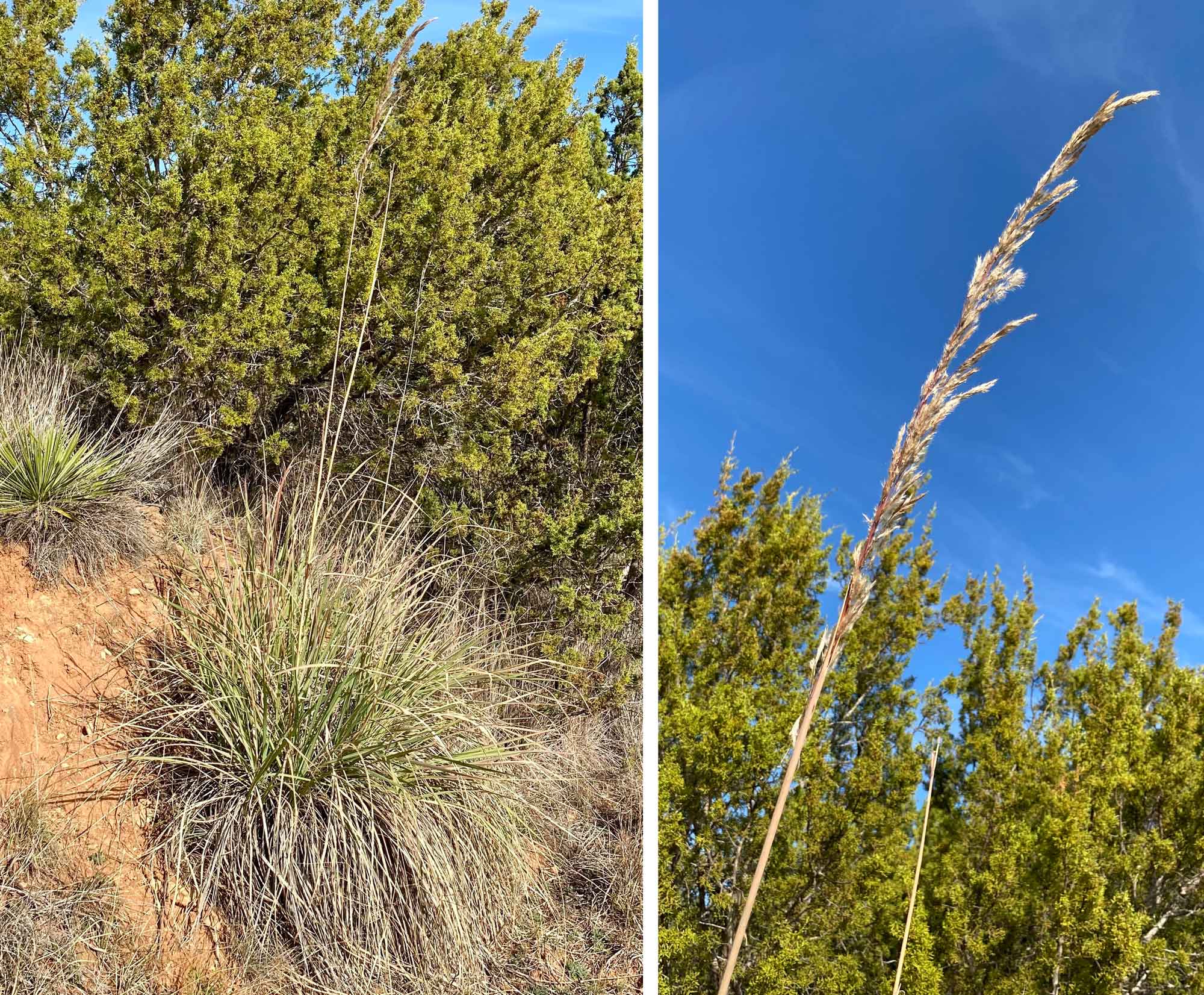
Ravenna grass (Tripidium ravennae), Sweetwater, Texas, U.S.A. This grass is considered an invasive weed in parts of the United States. Photos by ck2az (iNaturalist, Creative Commons 4.0 International license, images cropped and resized).
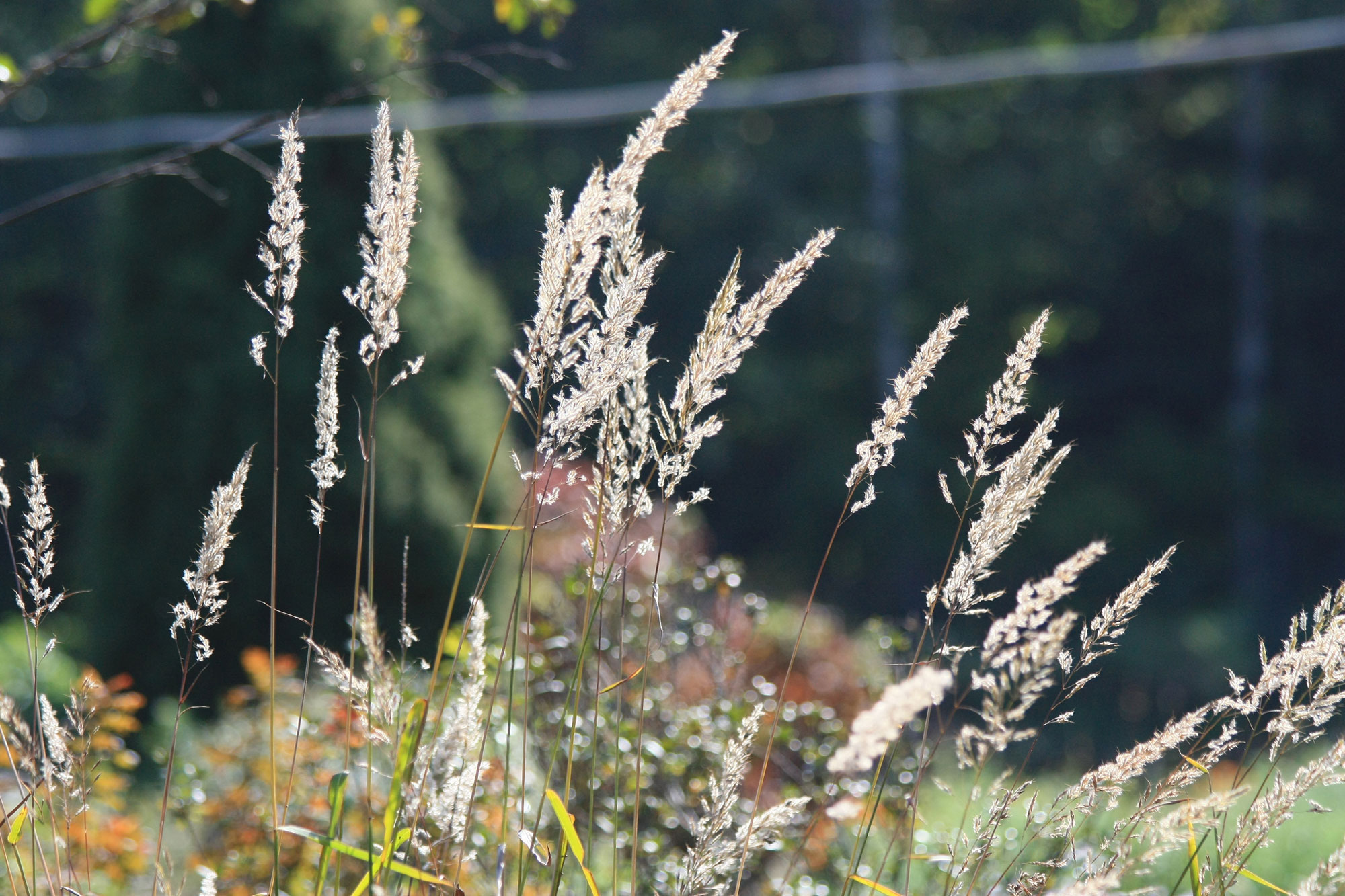
Frost grass (Spodiopogon sibricum), Russian Far East. Photo by Valery Kambalin (iNaturalist, Creative Commons Attribution-NonCommercial 4.0 International license, image resized).
Resources
Websites
Angiosperm Phylogeny Website (P. F. Stevens): http://www.mobot.org/MOBOT/research/APweb/
GrassWorld: https://grassworld.myspecies.info/en
Imperata cylindrica (Bugwood Wiki): https://wiki.bugwood.org/Imperata_cylindrica#cite_note-holm-2
Invasive Plant Atlas of the United States: https://www.invasiveplantatlas.org/grass.cfm
Itchgrass (Texas Invasive Species Institute): http://www.tsusinvasives.org/home/database/rottboellia-cochinchinensis
Kew Plants of the World Online: https://powo.science.kew.org/
Plant Finder (Missouri Botanical Garden): https://www.missouribotanicalgarden.org/plantfinder/plantfindersearch.aspx
Books, articles, and reports
Boyd, J. D., Jr., V. Maddox, and R. Westbrooks. 2018. Itchgrass. Mississipi State University Extension Publication 3186 (POD-02-18), 2 pp. http://extension.msstate.edu/publications/itchgrass
Scientific literature
Arthan, W., L. T. Dunning, G. Besnard, S. Manzi, E. A. Kellogg, J. Hackel, C. E. R. Lehmann, J. Mitchley, and M. S. Vorontsova. 2021. Complex evolutionary history of two ecologically significant grass genera, Themeda and Heteropogon (Poaceae: Panicoideae: Andropogoneae). Botanical Journal of the Linnean Society 196: 437-455. https://doi.org/10.1093/botlinnean/boab008
Soreng, R. J., P. M. Peterson, K. Romaschenko, G. Davidse, J. K. Teisher, L. G. Clark, P. Barberá, L. J. Gillespie, and F. O. Zuloaga. 2017. A worldwide phylogenetic classification of the Poaceae (Gramineae) II: An update and a comparison to two 2015 classifications. Journal of Systematics and Evolution 55: 259-290. https://doi.org/10.1111/jse.12262
Welker, C. A. D., M. R. McKain, M. C. Estep, R. S. Pasquet, G. Chipabika, B. Pallangyo, and E. A. Kellog. 2020. Phylogenomics enables biogeographic analysis and subtribal classification of Andropogoneae (Poaceae--Panicoideae. Journal of Systematics and Evolution 58: 1003-1030. https://doi.org/10.1111/jse.12691



